Category: Uncategorized
John Sparey’s “Family Letter” and Felix 1935!
This is a drawing by John Sparey from 1969 when we worked together on “Shinbone Alley”. He thought I had a rather gruesome sense of humor in those days, and he depicts me laughing at a moment of tragedy/suspense in a movie theater audience. What a monster I must have been! I probably had some half-baked theories about “black humor” that struck John as peculiar and worthy of commentary. Here is a letter that he wrote to his family in 2006, after John had his stroke in his Hollywood apartment and wound up in the Motion Picture Country House and Hospital for long-term care. His apartment remained full of his things and unoccupied for a long stretch while John was adjusting to his new life at the Country House. He talks a bit about a visit from Iraj Paran, former art director at Hanna-Barbera, and Liz and Mark Bakshi, members of Ralph Bakshi’s family:
May 4, 2006
Dear Family and Mark,
Let’s see. When did I write my last family letter? Was it before I composed my first computerized message to all on my Christmas Card list? Was it before I quit having meals with my own little “snake pit” group to enjoy meals in the hospital’s dining room with the hospital’s more functional patients? White table cloths, menus with choices between two entrees and a choice of side dishes. Food more thoughtfully prepared. This week’s return to meals on trays in our own quarters is a temporary setback caused by a flu quarantine.
Last week, I was moved from a double room on the first floor to a single on the second. My clock radio could now provide real music rather than just deliver white noise. I can play the TV with no concern for a blind roommate. I began to feel I was putting out roots.
This Monday, I went on an off-campus shopping spree. Best Buy and Target’s. Bought a larger TV with DVD and VCR to replace the set provided. I have a perfectly good early 90’s floor model RCA plus a DVD/VCR unit in my apartment. But they would be space hogs here. I was provided transport plus a volunteer shopper. I also got a new Timex. I got tired of people looking at the white spot on my wrist-bare since last December-and asking “where’s my watch?” Plus such odd items as a drawer lock and a new address book.
We have an attractive dark haired nursing supervisor here named Hiva Paran. (Hee Va Pa Ran) in conversation last week, she mentioned her husband Iraj. IRAJ PARAN?!! I had known and admired his work at Hanna-Barbera 35 years ago. He had a personal painting style exactly like ancient Persian miniatures. Both are from Iran/Persia. Iraj was new to the country and was hired for the background department by Bill Hanna within ten minutes of showing his portfolio. He stretched that into a career of over 20 years at the studio, becoming their art director. So yesterday, Iraj came to our facility for some X-rays, and stopped by for a visit. We had a cheerful chat and reminiscence about the “good old” days. He looks about the same now as he did then.
Today? Nothing much. Just had a visit from Liz Bakshi, Ralph’s wife. They live in Silver City, N.M. these days. Liz is out here visiting some of her kids. The oldest, Mark, lives just next door in Calabasas. I first met Mark when he was visiting his father during the making of “Fritz the Cat”. As they were entering one room, Ralph covered his eyes and said, “not until you’re eighteen”. When Mark completed his education, he got some executive position at Disney, but after several years he shifted to Paramount, where he has remained. Yesterday, Liz said that Mark has just been made President of Paramount [!] Liz is just as bright and cheerful as Ralph is loud and angry. We had a good visit.
(This is basically a letter for family distribution, but I just wanted to share some of the fun I’ve been having.)
John S.
I will be posting a few more letters from John soon, telling his further adventures at the Motion Picture Country House.
I’ve decided to take Felix back in time to the year 1935! I love the artwork and design of Felix in these early-30s strips. In 1937 there was an unattractive design change. So why not show Felix at his most appealing? In the dailies from 1-1 to 1-5, Felix opens a window in the Dooit house and a rather demanding owl flies in. He tries to blackmail Felix for food, but Felix ties his mouth shut with a napkin in the 1-4, (note the funny drawing in the last panel with the owl with the napkin tied around his head) and then tosses him out in the 1-5. In the Sunday, Felix actually WANTS to take a bath (not a favorite of cats), but then goes to sleep and floods the Dooit domicile. He winds up freezing and friendless outside.
In Krazy this week, 11-4 to 11-9-1940, the Coconino cast play games, including such obscure ones as a medieval child’s game called “Duck On A Rock”, see the 11-5. Mrs. Kwak-Wakk takes the “Drake” position on top of the “Duck” rock. They play “blind-man’s bluff” and Krazy cheats a bit at “Hide and Go Seek”. Offissa Pupp may have a bit of English Bulldog in him as he suggests they play “Cricket” in the 11-9, which Krazy konfuses with “Grasshopper”.
Patrick is from 8-8 to 8-13-1966 this time. My fool computer wouldn’t let me put the 8-13 strip at the bottom, so it’s running at the top! Actually the sequence works well, as Patrick steals money from Mommy’s purse, then has a framed exhibition of his “Portraits of Presidents” in the 8-8. I like the 8-10 and 8-11 as Partick tries to kill the taste of liver and onions with 16 bottles of “sody pop”, then blames his stomach ache on the liver! He’s so sick in the 8-11, he calls Godfrey a “nice fellow”. More from the Post-Dispatch on our next visit. Thanks for the great feed-back I’ve been getting lately. I even have a fan from Germany! Hi Klaus, glad you like Felix. Maybe someday David Gerstein will do a second Felix volume, he’s the King O’ De Cats!
John Sparey on “The Funny Company”, and the end of 1936 Felix
Hi Readers, here is another 1969 John Sparey gag cartoon about my crazy laughter. That’s John and Mike Sanger to the left of the panel. Sometimes I’d get to laughing so hard that I would literally turn purple, and that’s what John is commenting on here. Actually, in laughing that hard, I would feel so embarrassed that I would blush at the same time I laughed. I still have a complex about blushing today, it’s just not “macho”, muchachos! Here is the text of a letter that John wrote to me in 2001. He remembers the heady freelance days of the 1960s when he worked for TV Spots and Sam Nicholson. He gets into some pretty technical talk about camera mechanics, but I feel that those “in the know” will be amused by it, and everybody else skip to the comics! Here it is:
July 9, 2001
Mark,
I generally hole up in my apartment on Sundays to take care of accumulated bills and correspondence (dated for the outgoing mail on Monday). (Mark here: I think that John lived either with his mother or by himself most of his life.) Although Lee Mishkin joined TV Spots (later Creston) during my time there, I cannot recall actually working on any of the same pictures with him. I tend to associate him with the “Fractured Fairy Tales” there, and chances are that he was on “Calvin and the Colonel”. He seemed pleasant enough and I liked his personal cartoon style of the time, but layout and animation tended to maintain separate cliques. As head of layout, Norm Gottfredson seemed to look down on animation as a necessary evil. (Mark here: I think that Norm felt about the same way when I met him at Fred Calvert’s studio in 1968.) But to me, he couldn’t draw a character the same way in two consecutive layouts. I felt that his heritage from his father consisted primarily of his strikingly similar build and the family name. His childish drawing style seemed a precursor to the prevalent styles today. I had little contact with Lee, and since that time have only seen him on rare social occasions.
As for “Linus the Lionhearted”, I don’t know where to start digging to find my TV cartoon references to see where that was animated. At TV Spots, we had the first season of “The King and Odie” (AKA “King Leonardo and His Short Subjects”). Shull Bonsall must have underbid the Mexicans for that one.
After Creston closed, and a year on “The Man From Button Willow”, came a year with Sam Nicholson on “The Funny Company”. He was then located at the animation center on Homewood, south of the Cinerama Dome. Libby Simon’s mother was a partner in a cel service in the same building. They worked on “T.F.C.”. Jerry Nevius rented a studio there, and while we were there, he hired Bill Littlejohn to work with him on the first Tiger Paws commercial. But then Bill got all the following Tiger Paws spots. And Chuck Jones set up there before moving to Tower 12. (But that must have been a later time.) Bob Bemiller and I rented space there to work on “Funny Co.”. He provided the desks. That was my only job on which I could deduct business expenses. We were the entire animation staff, working on separate episodes. I never saw who did storyboards or layouts. (I’m not sure we had layouts.) Dave Hoffman worked in Sam’s office doing animation checking. I don’t recall who did backgrounds.
The show had less than a shoestring budget. In one shot, I had Belli Lagoona (Mark here: Belli Lagoona was the Bela Lugosi type villain of the series.) peering out from behind a pier piling. I gave him two dialogue positions with one inbetween. When we saw it on screen, Belli did an odd hop between lines. The man from Mattel (which bartered the show) turned quizzically and almost asked something. But he held his tongue. The scene aired that way. I tracked down the cels and drawings and found that it (the inbetween) was inked with the drawing resting against the pegs and then was registered to the B.G. (Mark here: In other words, the drawing was not on the pegs when it was inked.)
In another episode, a British chap had a held body and separate head positions. To avoid bad registrations, the head was exposed on a level below the body, with the neck painted generously below the collar line. So it was shot with the head on top of the body and the flesh color slopping down over the shirt. I was glad it wasn’t one of my shows. It aired that way.
I had another shot of Belli screaming as the plane he was flying headed right at camera. Limited to a 12F setup, and with no copier or enlargement facilities, I used a center to center truck from a 12F to a 4F, one field at a time. Then enlarging what would have been a 3F–using the squares method of enlargement—and trucking from 12F to 4F in half as many frames as before, then enlarging the 2F and trucking in about 2 frames. Then I had to go onto ones until the screen was the black of Belli’s mouth interior. It was hardly the world’s smoothest continuing truck, but it matched the product.
I don’t see myself enjoying the Smokehouse packed mostly with strangers, but thanks for asking. (I think I tried to invite John to lunch at The Smoke House, a North Hollywood eatery on Caheunga Blvd., but can’t remember why.)
Turning out a 3 minute animated film in this day and age seems a rather masochistic project. Who gets to see it? But if “It’s ‘The Cat’” is ever released for the public, please let me know. I can’t see it on the Internet, I don’t have room for a computer.
John S.
I think it’s rather funny that John thought I was a masochist for making “It’s ‘The Cat'”, maybe he was right! The second short still has not gone before the cameras as yet, but ol’ masochistic me still lives in hope that it will happen soon!
Felix is from 5-11 to 5-17-1936 this time with a copy of the daily for 5-20 thrown in. Snobbs the butler comes to the fore as Felix’s menace this week. Socky McSwat, the bodyguard appears for the first time in the 5-13, and keeps beating up Snobbs. The Sunday, has Snobbs believing that Felix is a jinx, then loving him after Felix causes Snobbs to lose ten pounds. Unfortunately, I still haven’t found the Felix dailies for 5-18 and 5-19-1936. If I find them, or one of my readers could send them to me, I would be very grateful. If you now go to the post for August 15th, 2009, you may read the entire Felix year of 1936 minus the two dailies. Next time, we will still have Felix with us, but from a different year.
Krazy is from 10-28 to 11-2-1940 this time. Bricks and Jails take a big part of the gags, and a tourist drops in on 11-1 and gets the grand Coconino tour from Ignatz and Offissa Pupp. I wonder if any enterprising souls ever considered building a real adobe “Jail” near the Navajo Tribal Park in Monument Valley, with Herriman artifacts inside? Garge fans from all over the world would come there, I betcha. By the way, what does Ignatz mean by “Kay Fotchi” in the 10-31?
Patrick is from 8-1 to 8-6-1966 this time. My favorite gag is the 8-3, as Godfrey explains to Elsa why he remains Patrick’s friend, even though Patrick is abusive. This kind of gag shows that Patrick’s mystique is growing, he is a potent character even when offstage. The last strip remember is from August 6th, exposing the depth of Patrick’s greed. More of Patrick from the St. Louis Post-Dispatch next time.
Sparey on Iwerks, John’s Letters Continue
Hi Readers! I’m printing John Sparey’s letter from 1999 reacting to Leslie Iwerk’s documentary, “The Hand Behind the Mouse”. I was a part of the film, Leslie interviewed me at my desk at home, answering questions about Ub. I was known as a big fan of Ub’s animation and his cartoons, such as Flip the Frog and Willie Whopper. I got to meet Ub at the Burbank studio in 1962. I found myself riding in an elevator with him at the Animation Building. I told him I really admired his work and enjoyed Flip and Willie. His reply: “We don’t talk about that stuff here.” That closed the conversation. Above, you will see the only panel I’ve ever found from a Flip the Frog comic strip or comic panel. It came from an old photography magazine. Ub definitely drew it, that’s also his lettering, compare it with the early Mickey Mouse strips he did. Does anyone have any further information on the Flip strip? David? Cole? The little drawing near the Iwerks is a caricature that John Sparey drew of me, once again sending up my cackling laughter. I thought this one would be appropriate for Easter, it shows me as a bunny with a bunch of colored eggs that I “laid”, see the post from last month for more info. Here’s John’s letter:
Oct. 11, 1999
Mark,
I was one of five people at the first Friday showing of “The Hand Behind The Mouse”. I realize that you were not involved in the making of the film, but I wish to comment on some aspects of it, and I don’t know those other people.
I was a bit bemused by the direct link between the scandals of Fatty Arbuckle (1921) and Wallace Reid (1923) and the frocking of cow udders (1933).
I had known that Ub’s first name had been Ubbe, but I was interested to note that although his screen name on those first mouse cartoons was Ub, in Roy’s 1930 letter to Walt advising him of Ub’s departure, he still used the name Ubbe. But an early cartoon from Kansas City had the combined name “IwwerksDisney”, with a double W. That shot was reprised later in the film. But I had not recorded the name on his Father’s patent papers, shown earlier, for comparison of the family name.
Certain time lines were unraveled and regrouped for what would seem like clearer continuity. Mickey’s career was followed well into the thirties before leaping back to Ub’s leaving. And his return to the studio in 1940 would have been before Walt’s involvement in the war effort. His development of traveling mattes was followed through to the end before backtracking to his Xerox work, which was presented as if in full bloom with 101 Dalmatians.
I apologize for repeating any of the following info that you may already know. The first use of Xerox in animation that I was aware of was on animation of Maleficent, for which roughs no more than 11/2″ tall were blown up for cleanup and then reduced to the original size for inking onto cels. Your were probably glued to the TV set when “The Art of Animation” was presented on Disneyland. For one segment, a garbage can quartet was Xeroxed on cels to simulate a pencil test. (Mark here: John is referring to the Disneyland show “Adventures in Fantasy” #5708, 1957). According to Ed Solomon,the animation had to be reworked about three times before Walt was satisfied that it looked rough enough for a pencil test. (As opposed to an earlier segment for which the Soup Eating sequence from Snow White was cleaned up to be shot as an actual pencil test. Yes!! I did cleanup on the seven dwarfs!) (Mark: This show was “The Plausible Impossible” #5644, 1956.) I left the studio in 1958 after completing my dragon chores. The first Xeroxed animation to reach the big screen was in “Goliath II”, in which some construction lines were left in the finished product. Then came 101, etc. I must admit that I have not seen the bulk of Ub’s work. I had never seen such a lengthy segment of “The Skeleton Dance”. And I was surprised to note that the music I had always assumed was in “Skeleton Dance” was actually in “Hell’s Bells”. (Note: Grieg’s “March of the Dwarfs”.) I can’t figure out exactly where the cow dragging its udder behind a screen and coming out wearing a skirt fits into the scheme of thing. (Note: This scene was in “The Shindig” 1930, before the Hays code was enforced rigidly.) While the Hays office was planning to lower the boom? Surely not after.And was God actually lifting his middle finger to the top of the screen? Or was I reading more into the shot than was actually there? (Note: This scene was used in the Willie Whopper cartoons “The Air Race” and “Spite Flight”, 1933. It was actually supposed to be St. Peter, a diabolical pun, when you realize St. Pete was flipping off the aviators because they wouldn’t offer him a ride.)Eric Cleworth told an anecdote of watching Flip the Frog on early TV with his daughter. Flip was skipping from stall to stall of a barn with a couple of milk pails. Each time he disappeared, there was the sound of squirting milk. When he went into the last stall, there was a loud bellow, Flip came flying out, and a bull stuck his head out, saying “That Hurt!” Eric’s daughter had to ask him what he was laughing at. (Note: This scene is from “The Milkman”, a Flip cartoon, 1932.)It was 1963 before Robert Mitchum tried milking a bull in “What a Way to Go!”Should Ub Iwerks be considered the Kricfalusi of his day?John S.And what is that animation desk you are sitting at? It seems like one I saw in a museum once. (Note: Leslie Iwerks shot the interview with me sitting at my old Disney Inbetweeners desk. I’m surprised John didn’t recognize it, as they were in use when he worked at the Burbank lot.)
Felix is from 5/4 to 5/10/1936. Felix literally “blows the whistle” on the kidnappers and returns home to Danny. He gets by Snobbs the butler in a hat box and soon encounters the new family pet, a bulldog! Danny points out in the 5/8, that Felix “brought Dad his millions..” How nice that Danny remembered that! In the Sunday, the storylines more or less tie together, as Felix returns to the Dooit household by way of the Professor’s farm. The poor little cat is immediately tied up in the backyard as a welcome home present!
Krazy is from 10/21 to 10/26/1940. The peculiar humor continues as in the 10/21, where Krazy switches the gender of the love interest in “Mighty Like A Rose” midstream, disappointing BOTH Offissa Pupp and Ignatz. I didn’t know Ignatz felt that way about Krazy. The 10/23 has Krazy waiting for the moon to turn on again as he sings “By the Light of the Silvery Moom”. In the 10/24, Krazy has a “hife” full of “B’s”, and they are “rilly” the letter “B”s.
Patrick is from 7/25 to 7/30/1966. He waps Godfrey over the head with Godfrey’s golf club, smashes Mr. Dunn’s window with a baseball, and never cries at movies. Patrick is the central focus of the gags this week. In the next post or two, Felix will have come full circle to 5/20/1936 and will complete our reprint of the year 1936. I am short just two dailies, 5/18 and 5/19/1936. Can anyone help me find them? Cole? David? Any other Felix strip collectors out there? See you next time!
John Sparey’s Letters Part Two
Hi Everyone! I’m very pleased with the high quality of response I got to my last post on John Sparey. Thanks to Charles Brubaker, Daryl Boman, Bob Jaques, James Tim Walker, Bruce Woodside, Scott O., Keith Scott, Bronnie Barry and David Nethery, the comments were really good! Bruce Woodside had the most meaty essay, refer back to the comments on the last post to read it.
The cartoon above was drawn by John Sparey in response to an embarrassing incident that happened to me on my 21st birthday, that summer of 1969. Mike Sanger and I went to a local bar at lunch to get my first legal drink to celebrate. I didn’t have a driver’s license yet, since I didn’t know how to drive and didn’t learn until 1970. When the barkeep asked to see some photo ID, the only card I had to show was my Mickey Mouse Club card which I got in 1955 (picture above). I flashed the card, and the next thing I knew, I was out on the pavement. Of course, Sanger got a tremendous laugh out of it, and when we got back to the studio, made sure everybody knew what an ass I’d made out of myself. As I recall, John didn’t react at all, but an hour or so later, presented me with the cartoon above. I wonder if John ever tried to crack the humor magazine market, he really had a talent for the one-liner gag cartoon.
In this letter he wrote in 2004, John talks about his final job in animation, his retirement, and then proceeds to critique the last 6 or 7 Disney “flat”, as he called them, animated features. John could be quite an acid critic, and I can still hear his tone of voice as I re-read his letters. He always sounded almost unemotional, yet sophisticated, as if wearing an invisible lorgnette on his nose, with his head held high, looking down at you. Remember, none of the opinions expressed are mine, nor necessarily of this blog, but Mr. Sparey’s alone: (By the way, Bruce, John mentions you in this letter.)
April 7, 2004
Mark,
I saw the L.A. Times article in which they firmly planted their tombstone on the history of flat animation, but I waited to see “Home On The Range” before making any kind of response. When Bill Schultz, at Film Roman, put me on a “call when needed” status, (like never) I mentally summed up my M.P. retirement benefits, social security, IRA and 401K savings (yes, Film Roman had a 401K plan) and began retirement wheels rolling. However, the Union put me on their “available” list. I got one phone call from a company I had never heard of. And they had never heard of me. They asked me to bring in my portfolio. Portfolio?!! My last portfolio when I started at Disney was a scrapbook of my college cartoons. The rubber cement holding them in place had dried up decades ago. Most of my jobs since then linked from one to another. Our conversation was brief.
I got another call from Richard Rich (Nest Anim.). On the recommendation of Bakshi alumni such as Steve Gordon and Bruce Woodside, I was asked to help finish “The Swan Princess”. So my last three months of work were on the board, rather than telling others how to do it. June 30 will be the tenth anniversary of my final work day. “Swan Princess” had seemed like a worthy contender, but Disney took care of that by reissuing “The Lion King” on its opening day. Sadly, although the first two sequels escaped briefly into a few theaters, neither came up to TV standards. A few years later, Rich came out with another disappointing feature (which I forget) made in partnership with another company (which I forget). This was followed by the preschooler parody of “The King and I”, in partnership with Rankin and Bass.
Incidentally, for all I know, “Swan Princess” may have been the last animated feature to have all of its animation completed in the L.A. area. The crew included people from every decade of my career, dating back to Gordon Bellamy and Sheila Brown from the Disney fifties.
From my Bakshi days, I have though of Rankin and Bass as “Rank and Base”. When “The Hobbit” turned up on TV while “Lord of the Rings” was still in production, Ralph found the precise Arthur Rackham illustration that they had used for their ugly Bilbo model. (Where is Paul Coker when you need him?)
But enough about me.
It was good to learn from the article that some of the “good guys” such as Floyd Norman and Tom Sito, are still in there trying. You probably know the story of how Floyd almost got into the B.G. Dept for “Sleeping Beauty” on the strength of one painting—until somebody got a look at him.
I made a point of seeing “Destino” during its brief December release. If the final rendition was anything like the original concept, I think that Walt made the right decision. I noted that its copyright was 2002. When I spent time in the Art Props Dept. at Disney between features, I came across photostats of Dali storyboards, but all I remember is the image of ants crawling out of a hand. Yes, that was in the short, but without any Dali look. Overall, the picture looked as if it had been done on several different continents, without much coordination. My primary after image is of figures flitting off into the distance. And of course it contained some of Roy’s required computerized BG movement. But I hope that Roy will still win his duel with Michael Eisner.
If “Home On The Range” is truly the end of the line, at least the genre didn’t go out with a whimper. I thought it was far better than much of the recent crop. I only objected to all those sharp points on the cows’ muzzles. In the crowd of names in the credits, I only managed to snag two onetime co-workers: Dale Baer and Renee Holt. If you don’t know (but you probably do) Renee was once one of Rudy Gernrich’s shaved-head Unisex models. I also spotted a couple of names that could be younger generations: Hester and Aardal.
If I ever have a chance to see “It’s The Cat”, I trust that my reaction will not be as negative as it was to “Destino”. But then I only know your personal style from over thirty years ago.
For me, the last truly satisfactory Disney flat was “Tarzan”, even though each of the lead characters appeared to have been designed for a different project.
Hedda Hopper’s newspaper column once made reference to “Monstro, the Singing Whale from ‘Fantasia’”. Of course, “Fantasia” was whale-free until the invasion of the space whales in “Fantasia 2000”. Incidentally, I find the current United Airline commercials more diverting than the Hirschfeld-influenced “Rhapsody In Blue”, which seemed like an effort. Not knowing your contributions to the feature, I shall refrain from further comment.
Other features? “Treasure Planet” was the “Ishtar” of animation. The grotesque animation was overwhelmed by those massive sailing space ships. “Atlantis: The Lost Empire” was for lovers of mechanical contraptions. “Lilo and Stitch”? Sort of mushy. “Brother Bear” seems hardly worth making—in the spirit of “Spirit”. “Ice Age” was nice. If “The Road To El Dorado” was meant to evoke Hope and Crosby, the corporate choice of voices seems to be disastrous.
Judging from the trailers, “Shrek II” looks like the giant gorilla for the year. The computerized “Garfield” moves his lips. That used to be a Jim Davis No-No.
I thought that “The Triplets of Belville” was Oscar-worthy.
I could go on.
John S.
Sadly, I don’t think John ever got to see “It’s ‘The Cat'”, he probably would have been critical of it, but he liked me, so he would have pulled his punches. I have many more letters that John wrote, mostly describing his retirement adjustments and his ordeal when he passed out in his apartment for several days, unable to call anyone on the telephone for help. We’ll post those as we go along. The response to the last post would indicate that you would like to read the letters, and I’m sure John would have appreciated being recognized.
In Felix this time, from 4/27 to 5/3/36, you could call the story line, “the cat came back”. Felix eludes the racketeers several times, with the old reliable tail substitute and balloon escape gags, but winds up back in the racketeers’ clutches, courtesy of Snobbs the butler. Meanwhile, Danny Dooit is frantic, and wants Felix back home. In the Sunday, I love the extra cats that Otto creates here, “Copy Cat”, who is a ringer for Krazy, and “Fraidy Cat”, a cute little white cat. Otto must have liked “Copy Cat”, as he brings him back for an encore in the last panel.
In Krazy, from 10/14 to 10/19/1940, Offissa Pupp is a pooped cop and his doctor prescribes “a rest” for him. Herriman has a field day with the pun, “arrest” and “a rest”, and gets a whole week’s worth of strips out of it. Even Krazy lands in jail.
Patrick seems to be channeling his inner Lucy this week, in the strips from 7/18 to 7/23/1966. “You’re Standing on my Shadow!”, etc. seem to be appropriate for Lucy to scream at Charlie Brown, at least the early Lucy. In the 7/23, Elsa’s deadpan remark: “One seldom sees such dedication”, seems to strike a Linus tone. Overall, though, Patrick seems as Mack Sennett to Schulz’s Hal Roach. There is a lot of hitting (WAP), screaming and general mayhem that Schulz used extremely sparingly. More next time, many Patrick strips yet to come. Thanks again, folks, for your great comments, enjoy reading!
John Sparey R.I.P. 1927-2010
See that laughing maniac up there? That’s a caricature of me drawn by John William Sparey back in 1969, more than 40 years ago. Here John is comparing my laugh to the sound of a cackling chicken. We were working for John Wilson on the animated feature “Shinbone Alley”. It was my first real job “on staff”, doing inbetweens. It was on that picture that my friend the animator Frank Andrina gave me my first professional scenes to animate on the Archy Declares War sequence, layouts by Sam Cornell. I also met among many others, the one-of-a-kind gent, John Sparey. John had been an assistant animator at Disney, animator at Hanna-Barbera, and worked on the original “Crusader Rabbit” TV cartoons in San Francisco in 1950 before working for John Wilson. My pal, James Tim Walker was also working as an inbetweener for Wilson that summer. The studio was in a ramshackle wooden building right across from the Colorvision studios lot, formerly Monogram Pictures, now it’s the home of KCET. Our wooden building was torn down years ago, the beat-up old animation desks were supposedly from the Disney Hyperion studio. Life there was a many-splintered thing. (John would have groaned at that one.) John, Bob Bransford and some of the other guys took great amusement at J.T. Walker and myself as we bumbled our way through the studio in our naiive fashion. I was an easy laugher in those days and used to laugh really loud, so John got a lot of gag cartoon material out of that (see above). John loved to draw gags about his fellow workers, but had excellent work habits himself and stayed at his drawing board most of the time. His drawings were very precise, and we marvelled at his effects animation as well as his character. He did a snow storm cycle for “Shinbone Alley” that looked very convincing, every drawing had the path of each snowflake closely delineated. John had what might be called a “closely-held” personality, he looked at animation as a profession and he seemed to derive little joy from it. His amusement came from a rather detached attitude of an observer and critic of his fellow animation toilers. He loved to draw gag cartoons, and would proudly walk through the studio with his latest cartoon held out before him at eye level. It behooved you to laugh at the cartoon!  Sometimes, if you crossed the line, John’s temper would flare up. John roomed with my old friend, Mike Sanger at Wilson’s. Mike was a very non-serious person, and John was a very serious one. Mike told one too many funny stories on a few occasions, and one morning, Mike came in to their room to find all his pencils broken, papers torn and his desk in total disarray. It was pretty clear who smashed the art supplies.  John Wilson had to put Mike Sanger in a different room. Here’s a cartoon John drew before the broken pencils started flying: 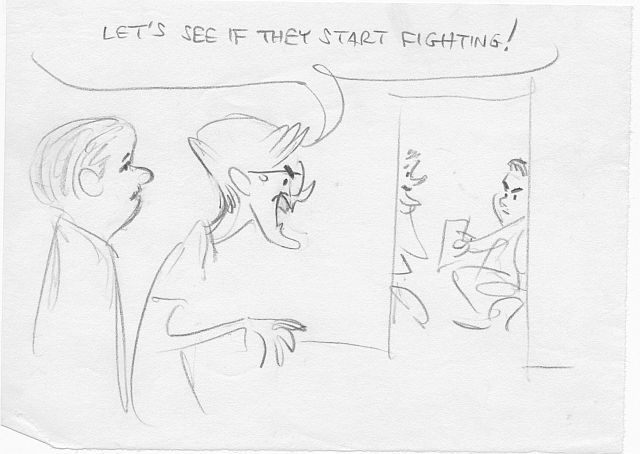  That’s me, and I think, James T. Walker lurking outside John’s room, John on the right, Mike Sanger on the left. If anyone is interested, I have quite a few more of John’s cartoons of the goings-on at the Wilson studio I could post. John Sparey passed away on December 15th, 2010 at the Motion Picture Country House in Woodland Hills, aged 83 years. Here, in John’s own words, is an overview of the start of his career, beginning at Jay Ward’s, through his Disney years:
 That’s me, and I think, James T. Walker lurking outside John’s room, John on the right, Mike Sanger on the left. If anyone is interested, I have quite a few more of John’s cartoons of the goings-on at the Wilson studio I could post. John Sparey passed away on December 15th, 2010 at the Motion Picture Country House in Woodland Hills, aged 83 years. Here, in John’s own words, is an overview of the start of his career, beginning at Jay Ward’s, through his Disney years:
In the summer of 1950, I stayed in Berkeley between spring and fall semesters for a chance to work on an animation project that was to be called the first animated series done for TV: “Crusader Rabbit”, by Alex Anderson (a nephew of Paul Terry) and Jay Ward, a real estate agent. They had two Disney veterans, Gerry Ray, who did storyboards pegged to serve as layouts, and Chuck Fuson, an animator. Bob Mills, a local boy, also animated. Joe Curtin was the writer. He had left a job at Terrytoons in New York by way of a window in the men’s room.
Come January, I graduated and went home to Indio. I hadn’t begun preparing my assault on the Hollywood animation industry when I got a phone call from Jay saying that the studio was moving south and asking would I join him. But of course! Coming with Jay were Alex, Gerry, Bob Mills, Joe Curtin, and their cameraman. Bob Bemiller was hired as an experienced animator. Ted Bemiller was a second cameraman. For the rest of the crew, Jay placed an ad in the classifieds. Among others, he got Dean Spille, Jerry Bowen, Jim Scott and Ed King. I’m fairly certain about those last two names. Dean made a career in the industry. Jerry stayed in the Screen Cartoonists Guild long enough to become business agent before stepping out of a high window. Jim was a compact Marine veteran with a hearty, easily triggered laugh. Once, he got pleurisy, which caused him a sharp pain when he laughed—which made him laugh again. The last time I might have crossed his path was in the Pantages theater once when I heard what might have been his laugh carrying across the width of the theater. Ed surfaced a few years later with some sample newspaper comic panels he had split with three other artists, each tackling the topic of the day. One of the artists was Roy Williams. The title was something like “Four in a Square”. I don’t know if it ever reached publication.
When the Crusader Rabbit shoestring broke in August, the Navy had already reminded me of my Inactive Reserve status. My last job for the studio was restyling the stock walk cycles to fit their evolution. We were helping Alex pack up everything when we took a break to watch Jay and his family and their St. Bernard take off for Berkeley in his MG convertible.
A season of watching civilians testing guided missiles out in China Lake carried me through 1952. I figure that the name China Lake tricked the Navy into thinking that there must be a body of water somewhere around.
I must have applied by letter to Disney, I got a meeting with Andy Engman, showed my college cartoon scrapbook, did test inbetweens of D. Duck and Snow White, and was accepted. A telegram asking me to start in March, 1953, made it official. Disney was no longer handling classified material, but new employees were still fingerprinted. “Melody” was being converted to 3D, and we were given an explanation in a tour of camera of how it was to be shot. Each frame was shot three times on B&W film stock using three color filters for three consecutive exposures. The Technicolor lab then used the film strip of three exposures with color filters to unify them in one image. That was how all Disney color animation was shot. But for 3D, art work had been split onto several levels, using as many peg bars as necessary. It was shot with one set of peg bar settings for one eye, which were then shifted by varying increments, to be shot three more times for the other eye. I filed all that info for possible future reference. The studio also shot a Chipmunk short in 3D: “Working For Peanuts”. But it wasn’t given much thought. A rear end view of an elephant drawn on one depth level fell–so to speak–flat.
We beginning inbetweeners honed our talents working on shorts. One specific I remember is “The Lone Chipmunks”, in which Chip and Dale faced “Peglegless” Pete. For their final triumphal scene they were astride a rearing steed. For that, a scene from “Ichabod” was destructively “borrowed” from the morgue. I erased the Headless Horseman from the saddle and some animator substituted the Chips. On “Lady and the Tramp”, I had no specific assigned position; I took whatever work was needed, moving up to temporary Breakdown during production. At some point around this time, I had my first specific connection with a picture. Bob Bemiller had joined Disney for the first time–not as a full animator, but essentially animating. The short was “Social Lion”, using the cat designed for “Lambert, the Sheepish Lion”. Bob tried introducing some limited animation techniques, but without much success. Perhaps he had asked for me to work with him.
Before “Lady” was wrapped, artists with specific talents were siphoned off to begin developing projects for Disneyland. I forget the order of events involving the end of Feature layoff, the planning of Disneyland the park and the TV show, the winding down of the theatrical shorts program, the Mickey Mouse Club, the highly stylized Disney characters turned commercial pitchmen for TV. I was off for only about six weeks from Oct. ‘54 to Jan. ‘55 before joining Esta Haight’s Art Props Dept. This was essentially a clearing house for locating model sheets, cutting BG overlays to mount on cels, dry mounting various art materials. Some times Esta actually found props for the M.M. Club. I developed a project to refile all of the model sheets by production numbers rather than by subject matter. As a reward, Esta let me take all the copies of models that I wanted for my personal collection and gave me property passes to remove them from the lot. But you know about all of that.
By July, I was back in the Animation pool, as an inbetweener. I was assigned to the Jack Kinney unit, which soon became the Woolie Reitherman unit. We started with doing bridges connecting old cartoons for the TV show. “The Great Cat Family” had a story of sorts of domestic cats from Egyptian times and on through Medieval ages with some inclusion of witchcraft (I think), and I forget what shorts were used. “The Goofy Sports Story” used a Spirit of the Greek Olympics to introduce various Goofy sports shorts, and “The Goofy Success Story” covered his movie star career, beginning with his discovery as a Extra in “Orphans’ Benefit” through getting his ears tied atop his head and hidden under a hat for the character parts of Mr. Walker and Mr.Wheeler in “Motor Mania”. I was in to see head of personnel, Andy Engman, and came back from another chat with Andy to say I was now an Assistant Animator. Somehow, “The Truth About Mother Goose” fit in to the transition to “Sleeping Beauty”. Woolie’s group got “London Bridge is Falling Down”. Bill Justice had a couple of segments, one of them being “Mary, Mary, Quite Contrary”(a.k.a. Mary Queen of Scots). I then began assisting with and cleaning up after, Eric’s dragon. I had enough loose time to turn out a lot of my personal color works during that time, as well as some personal pencil tests. (Which were encouraged, camera shot them.) One of these was of an abstract artist (i.e. the artist was abstract). Who would take slashes and slices with his brush at an easel turned away from the viewer. He would get excited by his work, do a little dance, trip, and tumble from the easel. He picked up his painting, looking shocked and dismayed. Sadly, he turned it toward the viewer, revealing Sir Joshua Reynolds’ “Pinkie”. This got shown around a bit. I had hoped it might show Ward Kimball something of what I could do with abstractions. Instead, Frank and Ollie saw something in it they liked: I had given my character a convincing body weight. I got a scene of Merryweather sitting on her bed ineffectually shaking her fists as she says: “OOOOO! I’d like to turn her (Maleficent) into a big old hop toad!”, lifting off the bed to accent “hop”. I thought I did a decent cleanup job. I must have had other scenes; I had reason to ask if the fairies’ wands should be part of character cleanup or left for effects. A simple decision, but in called for a Committee decision. Those two ruled lines should be done by effects. Anyhow, I soon found myself back tending Eric’s dragon. But there was one other distraction. By the time “How To Have An Accident In The Home” was completed, Walt decided that he didn’t like the new stylized look given to the Duck. So I got the job of rekeying the short in conventional fashion. I don’t know how much difference it made. I segued from following Eric’s dragon roughs to doing key cleanup, at which time I could give accurate counts of the plates down the Dragon’s throat, neck, chest, belly and tail. For scenes of the Prince slashing his way through the thorn forests and battling the Dragon, Ed Kemmer, starring as Commander Corey of “Spaaaace Patroool” for several years, was called in to perform astride a wooden sawhorse being rocked on a long handle by Woolie himself. I was surprised that a TV actor should be called in for such a function. Little did I know that he had provided live action of the Prince for the entire feature. Ken Hultgren, a specialist in animal action, did the horse. He needed no Rotoscope.
Bob Bemiller had left the studio prior to this. Another Assistant Animator, Ed Solomon, left the studio in late ‘57/early ‘58. Anyone who chose to leave the studio in those days had to write a Letter of Resignation, explaining why he was leaving. Ed’s excuse was that (he) would be helping his brother-in-law sell used cars. Along about March of 1958, work on the Dragon was beginning to wind down. Copies of “101 Dalmations” were going around the studio to familiarize animators with the next project. I got a call from Ed Solomon. He and Bob Bemiller were at a studio called TV Spots, which was starting a new Crusader Rabbit series in color. Would I like to join them? What? Leave Disney? I politely said no and hung up. I told Eric about the call. Noncommitally, he made some response equivalent to “It’s something to think about.” I could stay at Disney, expecting perhaps to become a career assistant. All. Those. Dalmatian. Spots. If I jumped, my base pay would automatically increase from $103.82 per week to $145.00 with built-in raises to follow. Within the hour I had called Ed back and said Okay. I had a chat with Andy. I wrote my letter of resignation. Janey, Andy’s secretary, typed it out. I signed it. In two weeks, I switched jobs on the weekend.
Bob was head of the animation unit. He was one of three Directors. I had to unlearn such animation niceties such as softening changes of dialog poses with inbetweens. My new walk cycles (from 1951) were used through the entire new series. I usually worked with Bob, but sometimes picked up from others. One scene I got from Paul Sommer showed a bird on a tree branch suddenly grasp his chest, as with a heart attack, and topple from the tree. Paul gave me specific instructions not to animate the action but use just one pose and provide positioning guides for that drawing. That’s what I did, but I handled the guides like animation, flipping them like drawings to work out the action. Paul said he had to study the scene very carefully afterward to determine that I had actually followed his specific instructions.
Now if he had said to make the action look fake, that might have been more of a challenge for me.
June 22, 2007
Are you there, Mark? When I began my brief career summary, I hadn’t realized how it would expand when I got into it. When continuing events began crowding around me, I broke off to write the enclosed family letter. Then rather (than) edit it or rewrite the pertinent parts of it, I decided to send it as is.
It’s my plan to continue my story after I have cleared up some of my other involvements. Libba’s book comes first, then the Bakshi book. Then back to my story. Unless you say “no more!!” It’s my intention to send you further installments as I get them done. Rather than send pieces of it to Mark Evanier or Jerry Beck or whoever for column fodder, anybody who is writing any responsible work on animation will be in touch with you, and you can distribute the material as you see fit. You can be my “agent”. I’m sure you can find a file folder for it. I have found memorabilia from all of my Bakshi films but “Wizards”. I’m hoping that it just got buried deeper in my storage unit and I am still awaiting delivery of that 24 pound pack of goodies salvaged from the Auction house. One of those nicknamed blogger buddies expressed the hope that they would be downloaded on the Internet for general availability. And it was suggested that whoever got them should eventually donate them to the ASIFA archives. Are ASIFA and the Animation Guild in competition for Archive collections? They should join forces.
I get the feeling that moving into a retirement home can enhance one’s reputation almost as much as being dead.
And it’s more fun.
John S. (Sparey)
Here is John’s Resume from his animating years:
John Sparey (Resume)
FEATURES
1955 LADY AND THE TRAMP
1959 SLEEPING BEAUTY
1965 THE MAN FROM BUTTON WILLOW
1966 THE MAN CALLED FLINTSTONE
1971 SHINBONE ALLEY
1971 THE LITTLE ARK
1972 THE WAR BETWEEN MEN AND WOMEN
1972 FRITZ THE CAT
1974 HEAVY TRAFFIC
1975 COONSKIN
1976 HEY, GOOD LOOKIN’
1977 WIZARDS
1978 THE LORD OF THE RINGS
1981 AMERICAN POP
1982 HEY, GOOD LOOKIN’ (final version?)
1983 FIRE AND ICE
1985 STARCHASER; THE LEGEND OF ORIN
1987 THE CHIPMUNK ADVENTURE
1993 TOM AND JERRY; THE MOVIE
1994 THE SWAN PRINCESS
TV SERIES
1950-51 CRUSADER RABBIT (B&W)Television Arts Prods.
1958-59 CRUSADER RABBIT (Color) TV Spots
1954 (?) THE KING AND ODIE (KING LEONARDO AND HIS SHORT SUBJECTS)
First Season-TV Spots
1960-BEANY AND CECIL –Bemiller (Snowball), 3 months
1960-61 FRACTURED FAIRY TALES, TV Spots (Jay Ward)
1961-62 CALVIN AND THE COLONEL -CRESTON (Was TV Spots)
1963-64 THE FUNNY COMPANY–Sam Nicholson, Mattel
1964-69 The Final Prime Time Flintstones-Jonny Quest-Atom Ant-The Impossibles-Space Ghost-Dino Boy-Laurel and Hardy-Birdman-The Herculoids-Moby Dick-Mightor-Abbott and Costello-The Three Musketeers-The New Adventures of Huck Finn-It’s The Wolf-Scooby Doo-Where’s Huddles?-Josie and the Pussycats-You name it and I probably worked on it-Hanna-Barbera
1988-89 U.S. ACRES (GARFIELD AND FRIENDS) Film Roman, CRO-Film Roman
1987 THE NEW ADVENTURES OF MIGHTY MOUSE-Bakshi
DISNEY SPECIALS
1953 MELODY -3D
1954 SOCIAL LION
1955-56 (?)Bridging old Goofy shorts for TV
(?) The Great Cat Family for TV
THE TRUTH ABOUT MOTHER GOOSE
1956(?) HOW TO HAVE AN ACCIDENT IN THE HOME
1985 STARCHASER; THE LEGEND OF ORIN-First 3D Animated Feature
ALSO NOTED
1962 WIENER COMMERCIAL-Sam Nicolson
1969 ARCHIE LAYOUTS-Filmation
1971 A SESAME STREET QUICKIE- Fred Calvert
1971 BIG YELLOW TAXI-Video-Fine Arts Films
1972 TITLE ANIM. FOR SATURDAY MORNING SPECIALS-Fred Calvert
1972 NANNY AND THE PROFESSOR-Sat. Morn. Specs.-Fred Calvert
1983 EXPERIMENTAL SHORT SHORTS-Ralph Bakshi
1987 HARLEM SHUFFLE-Video-Ralph Bakshi
1988-92 GARFIELD PRIME TIME SPECIALS-Film Roman
1993 VIDEO COMMERCIAL FOR SIMPSONS-Film Roman
1993 NICK AND NOEL-Toys R Us-Film Roman
                                                            John wanted me to spread the story of his career around, but he never sent me any further installments. By the time he sent me this letter, 2007, he was in the Woodland Hills Motion Picture Home, and in pretty bad health. If there is any interest, I will print a few other letters he sent me, where he analyzes recent Disney features and gives me a little career advice. It’s hard to believe that more than two months have gone by since John died, and I learned about it from the TAG website. The last time I saw John, was in 2006, at a screening Jerry Beck and I hosted of some “Calvin and the Colonel” TV episodes, a series John animated on. We showed them at the AFI screening room, and John Sparey, Frank Andrina, Mark Evanier, Earl Kress and a few other people attended. John was already pretty feeble at that point, and walked slowly and talked more slowly than that. Some of his wry humor about the show seeped though the gloom, however. I shall miss his letters, John was a pro to the end.Â
Felix, from 4-20 to 4-26-1936, continues the extortion plot. Felix escapes from his kidnappers, and Mr. Dooit, forgetting that Felix put the Dooits on Easy street, offers the catnappers $1000.00 to take Felix off his hands! In the Sunday, Felix is once again kicked out by the Professor, and Messmer shows that he can draw funny goats in the last panel.
In Krazy, from 10-7 to 10-12-1940, Ignatz tosses bricks that do curves in the air like a baseball, and Ignatz does a perfect imitation of Krazy’s Yiddish accent in the 10-12. He even fooled Offissa Pupp. I wonder if John Sparey would have liked these strips?  Â
I’m playing “Catch-Up” with Patrick this time, from about 7-8 to exactly 7-16-1966. On the 7-13 episode, I began to include the by-line, so it makes the strips a little larger. Patrick makes a fine art out of cheating at croquet, and is ecstatic about making Suzy hate him. It seems very obvious that it’s Godfrey Snodgrass hiding in the trash can in the 7-16 strip. John Sparey never really got into computers very much (lucky him), but lived to see a lot of his collection of his drawings go up on Ebay without his consent! If I get any comments on this post, I’ll print more of John Sparey’s drawings and letters. I guess there wasn’t much interest in my Mother’s song from last time, it’s OK.
   Â
                        Â
My Mother Sings!
Hi Readers, it will soon be Valentine’s Day. For some reason, it reminds me of my mother. I still miss her very much. My brother keeps finding odd bits of memorabilia that Mom saved. The one upstairs is a photo of the KXOK Choristers from radio station KXOK in St. Louis in 1939. My Mom is in the front row, to the left of the microphone. How I would love to hear what those Choristers programs sounded like. I also included a bit of the local radio listings from that day, I’ll bet the Jitterbug Jamboree, the Black and White Revue, “Ernie” Fio Rito’s Orchestra (Ted’s brother?), the Gay Nineties Revue and Frankie “Trombar”‘s Orchestra ( probably Frank Trumbauer) programs were musical gems! Probably no transcription discs were saved, as the only way to record those shows in 1939 was at 78 RPM. Speaking of transcriptions, go to www.archive.org/details/HymnToTheSun to hear a home recording of my mother singing this “Air of the Queen of Shemakha” from the opera Le Coq D’Or by Rimsky-Korsakov. It was recorded on a direct-to-disc Sears Silvertone machine on March 23, 1941 when Mom was 22. She recorded this solo with my Grandfather Fred playing the piano and is my favorite of many discs she cut in the early 1940s at home. The old record is very scratchy, but if you listen carefully (only 3.5 minutes, folks) you can get a sense of just how beautiful her voice really was. I love the Oriental Exoticism of the “Hymn to the Sun”, and Mom really captured the song’s difficult rises and falls in pitch. She hits a very high note towards the end of the side that thrills me! She was so talented, and is still very greatly missed by her sons. Entertain the world, Mom, we love you!
Just above is the first “Gordo” daily strip, from Nov. 24, 1941, created by Gus Arriola. A collector named Bruce Rosenberger is posting them at www.ilovecomixarchive.com/G/Go. Go there to read almost all the dailies from 1941 and 1942. On Oct. 28th, 1942, Gus stopped the Gordo daily to enter the Army and work for Major Rudolph Ising at the First Motion Picture Unit in Culver City. I’ve been waiting a long time to see these strips. I’m only posting the first one here to whet your appetite as Bruce spent a lot of time and money uploading these. As much as I love the 1950s Gordos that I grew up with, I love these pre-War Gordos even more, because they look so much like the MGM cartoons that Gus Arriola worked on, such as “The Lonesome Stranger”. Check out the book, “Accidental Ambassador Gordo” by Robert C. Harvey and Gus Arriola at your local library. It’s a great chronicle of what should be a much better known strip. Gus Arriola was born in Florence, Arizona, so he was an American citizen, with Mexican parents. The main reason why the early Gordos are not reprinted, is that they are the most stereotyped versions of the characters. Gordo is really fat and lazy, almost a Latino hillbilly, resembling a Dogpatch citizen. Senor Dog and the pig really look like they are from a Hugh Harman cartoon, and the dialog is a lot more “Mexican” sounding than it was later on. Gordo was a romantic from the beginning, about the only thing he could get out of bed for was to catch a sight of a “poorty gorl”, much to the dismay of Pepito, his nephew. There really is no hatred in the stereotyped portrayals of any of these Mexican characters. Arriola was using comic exaggeration to make Gordo and his world funny and accessible to his readers. He used many Spanish words in the dialog and gave a lot of cartoon lessons in Mexican art and culture along with the slapstick romance. I Love Comix archive has hundreds of major and minor comic strips to read, all at no charge, terrific site!
Felix still is treated like an alley cat by the Dooit family in the strips from 4-13-1936 to 4-18. Butlers grab Felix’s “ears” and tail and finally he is captured by a couple of crooks who think he is a good luck mascot to aid their malicious trade. In the Sunday (4-19), Felix still lives with the Professor, but has to sneak back into the house at night. He tries to help a dog keep warm with a pair of the Prof’s polka-dot pajamas, but the spots come off on the dog’s white coat. Felix has made another enemy.
Krazy this week (9-30 to 10-5-1940) features the eternal (for four more years anyway) battle of wits between Offissa Pupp and Ignatz over his deeply ingrained brick-tossing habit. Look at those lovingly crafted interiors that Herriman draws in the 10-4 and 10-5 strips. Ignatz and Pupp both live in nice little houses with candlestick telephones and comfy couches. I wonder why Ignatz is noting that it’s leap year in the 10-3 strip? This feels like it belongs on February 29th! That’s Coconino for you.
The Patricks are from approximately 7-1-1966 to 7-7. The only certain date is the 7-7. In the next post or two, the strips should be back to more reliable dating. Godfrey, Godfrey’s tricycle, Suzy Smith, Elsa and Patrick’s Mother all are in the cast this time. Even though the dates to these strips are lost, the continuity with the tricycle episodes and Suzy’s flowers seems to work.
Last time, Charles Brubaker commented on my Animation Guild interviews. If you want to hear me spout off for a couple of hours about my career in the mosh pits, go here: http://www.animationguild.org/organize/audio/TAGInterview_MarkKausler1.mp3 and here: http://www.animationguild.org/organize/audio/TAGInterview_MarkKausler2.mp3
The interview has a lot of crazy stories about animated cartoons involving me and a few other culprits. The union is recording interviews with a lot of us scallywags including Tim Walker, Robert Alvarez, Kathy Zielinksi, Mark Kirkland, and many more.
And by the way Charles B., I do remember the strip “Conchy” by James Childress. It appeared in THE MENOMONEE FALLS GAZETTEÂ in the 1970s. The strip ended in 1977 when Childress committed suicide. Both Conchy and Patrick were created by cartoonists who didn’t live too long. I think Patrick is the lesser known of the two. I hope I can do another post again soon, good readers. See you then.
Guess the Cartoon
Hello Readers! Here’s a nitrate 35mm frame from a silent Mutt and Jeff (note it’s full aperture), which has been in my frame clips envelope for many years. It’s interesting that nitrate frame clips will sit in envelopes without any deterioration at all as long as they are fully exposed to air. Anyway, does anyone have any idea of which M&J this frame could be from?
Felix can’t get no respect again in the strips from 4-6 to 4-12-1936. Felix has to get all spiffified and pretty to stay in Danny Dooit’s house this week, he envies the pigs! My favorite gag in the dailes is the 4-11, as Daddy Dooit grabs Felix instead of his black tie. This was a yuck! Messmer is in top action form in the Sunday page for 4-12, I love the boxing glove and frog drawings in Bobby Dazzler and Felix’s expression as he lands on the sprinkler in panel seven of his own strip is beautifully drawn.
Krazy from 9-23 to 9-28-1940 is mostly Mrs. Kwakk-Wakk’s moment to pry into everybody’s business. I like the discussion of Krazy Kat’s nature she instigates in 9-23, and the gag in the 9-27 is the “fourth dimensional” sort that Herriman loved to do, in this case the sound effect “PEEP” from Krazy’s egg misinterpreted by Mrs. Kwakk-Wakk as criticism of her actions. Garge brings back the “Doormouse” once again in the last panel of the 9-28.
Patrick continues to dominate Godfrey Snodgrass this time in strips from about 6-25-1966. These are not precisely ID’d date-wise, but the continuity of the strips seems plausible, so they could end with 6-30. This must have been early in the day of skateboards, Patrick takes an instant dislike to his in the 6-26 (?). Godfrey loses control of his tricycle to Patrick in the 6-28 and 6-29 (?) episodes. If any on you comic strip mavens can more precisely nail these down, please let me know.
Thanks to Paul Penna and Charles Brubaker for your comments last time. I’m glad you liked the Snafu animation, Paul. It was enjoyable to do it, much better than storyboarding any day. I’m glad you liked the Snafu DVD, too Charles. I’m glad you enjoyed our Christmas card. See you readers (both of you) next time! Happy New Year!
Dublin’ Oop!
Erin Go Braugh! It’s a little early for St. Patrick’s day, but I’m Dublin’ Oop this week anyway, you’ll see what I mean further along. Steve Stanchfield’s magnum opus: Private Snafu: Golden Classics, is now available through Amazon.com or your favorite video retailer. I like it, but the first new animation I’ve done in quite a while is in there, so I’m prejudiced. The transfers are really first rate, almost all of them from 35mm, the few 16mm ones are almost as good as the 35mm stuff. It’s loaded with commentaries from John K., Mike Kazaleh, Eric Goldberg, Jerry Beck and Mark Mayerson! Mark rarely does commentaries, so get the disc just to hear his voice! I listened to all of them, and they seem pretty accurate for the most part, what can you say in three minutes? I can’t help wishing we could have had Bobe Cannon, Rod Scribner, Bob Clampett, Bob McKimson, Cal Dalton and Chuck Jones doing the commentaries, but they are looking on from another dimension. Eric Goldberg did the cover and supplied more than half the commentaries himself. He can spot Ken Harris’s animation almost every time, I can’t tell Ken’s stuff from Benny Washum. John K. didn’t spot Cal Dalton’s animation in “Booby Traps”, but he’s very accurate with the McKimson and Scribner scenes. Even the rarest “A Few Quick Facts” cartoons made it on to the disc. Steve struggled with the 35mm master materials in the National Archives for years to get the copies on this disc. He spent many hours and a lot of his own money to clean these up. The Snafus never looked better, so support the effort, buy two or three and store them away to give as gifts. Maybe donate one to your local library! Auction off your old “The Complete Private Snafu” VHS tapes on Ebay! (Just joshin’.)
Two weeks worth of your comic favorites are my New Year’s gift to you, readers. Here is Felix from 3-23 to 4-5-36. Felix brings home the diamond to Danny Dooit’s family, and the only thanks he gets are Father worrying about his income tax, the tough neighborhood dog wanting his “cut” and the snooty new English butler griping over Felix’s appetite. In the Sundays, Felix comes back to 1936 from the 6th century, and gets locked out of the Professor’s house again in the 4-5 episode.
Krazy is from 9-9 to 9-21-1940 this time. Herriman breaks the fourth wall a few times, in the 9-13, Krazy thanks Garge for the extra ink to disguise his black brick against a black sky. In the 9-14, Ignatz hides behind a fake background on a roller shade. In the 9-18, the Jail is just a set, and in the 9-19, Mrs. Kwakk-Wakk is confused about what is a set and what is real. The mysteries of Coconino continue next time.
The Patrick strips are from 6-13 to 6-24-1966, approximately. Not all the strips have the dates on them, but they are pretty close. Elsa is living her movie star fantasies, which makes Patrick so sick that he can’t slug her. Mal uses a very old joke in the 6-18 (?), “..with some it’s next to impossible.” Patrick lives very much in his own world, insulated by his selfishness, and Elsa, Suzy and Godfrey are each deluded in their own way, but usually serve as pawns for Patrick. Happy New Year, y’all. I’ll try to post more often in 2011, but that’s not a resolution! Remember to click on the thumbnails to enlarge the strips. Thanks for reading.
OOo Such a Hust-eling and Bust-eling!
Dear Readers, Merry Christmas, Happy Chanukah and all the other Variant Celebrations! Vic Vac of the old St. Louis Globe-Democrat, did Christmas, Halloween and July 4th special covers for the Sunday Magazine through the 1930s to the 1980s. He was a staff cartoonist who liked to use aerial perspective in his work, as in the Halloween cover I uploaded a couple of posts ago. This one is from 12-25-1977, and shows Santa taking a break from driving the reindeer to worship at a little mid-western church. Maybe he’s listening to my Mother singing “Oh, Holy Night”. I like the little touches Vic Vac throws in, like the fox, raccoon, mouse and birds with their Christmas stockings, the old horses and sleighs, the barn and farmhouse in the distance, down to the boots and overshoes laid out by the church door. These drawings were never syndicated outside of St. Louis, and they really remind me of a hometown Christmas.
Here’s the front cover of a brand new book by my pal, Tim Walker. Tim has done animation, assistant animation, storyboard and sheet timing for cartoon studios from 1969 to the present, we met at Chouinard Art Institute in 1968. There are few people I know who love cartooning like Tim. It was a real shock for him, when in 2007 his right arm grew very weak, and what he thought was Carpal Tunnel was diagnosed as Lateral Parkinson’s Disease. Tim was very worried, because he had always been right-handed. How would he draw and write now?
On June 11th, 2007, Tim took up his pencil and brush pen in his LEFT hand for the first time and drew the character above, his first drawing with his left hand. He kept working that hand, and soon began to fill sketchbooks with his appealing characters, gnomes, bearded dwarfs, batmen and batkids, cavegirls and caveboys and naked ladies. I like the shaded line he gets with the brush pen and the way he spots black shapes behind his figures helps to tie them together. The caveboy on the front cover is drawing a caricature of Tim with his left hand. Tim really loves to draw these characters, and almost always has a sketchbook with him. They are really fun to look at, and now he’s published this hardback book so everyone can share his story and the sketches. If you would like to order a copy, Paypal $25.00 to Tim Walker at gobofspitaa@yahoo.com . He will ship your copy to any place on earth. The binding is very nice on this book, it’s printed on beautiful paper as well.
Felix bids goodbye to Punk Chow and Fooy Tu Yu in the dailies from 3-16 to 3-21-1936 as he rides a gas balloon to the sky and boards Fooy’s airplane. Felix steals Fooy’s suitcase containing the diamond and waves goodbye to the escaping crooks. In the Sunday, 3-22, Felix is still trapped in the 6th century waiting for the scientist to bring him back to 1936 with the time-control. Bell-bottomed knights pursue him with axes and hope. Remember, just click on the thumbnails to blow them up.
Offissa Pupp becomes royalty in the Krazy strips from 9-2 to 9-7-1940. The 9-2 is a Herriman rarity, a continuity hold over from the previous week’s story. I like Ignatz’s defiant attitude toward Offissa Pupp’s royal assumptions as he finds that he is a Marquis. Does that make him a Don Marquis?
The Patrick strips this time are from 6-6, 6-7 possibly 6-8 or 6-9, 6-10 and 6-11-1966. There is at least one strip missing this week. Maybe one of my readers can supply it. Summers tended to be a little spotty with the newspaper, as Dad’s vacation time came around, the Post-Dispatch became scarce. Dad didn’t pick up a copy on his way home, he WAS home. Patrick beats Dagwood with his 24 decker peanut butter sandwich and apes Pigpen with mud puddle gags. Mommy is fully visible in the 6-10, a rare appearance.
Charlie Brubaker sent me this very early appearance of Patrick in an anthology strip called “Nibbles”, drawn by Mal Hancock, printed in an Ottawa paper. Â It dates back to 4-17-1961, so Patrick has been around for quite some time for a little-known character. The link doesn’t work too well, so here’s the strip: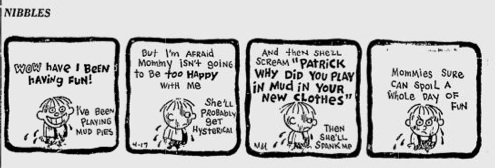
Thanks Charlie, for finding this!
Listen my readers and you shall hear a Christmas tale from Bret Harte, author of “The Outcasts of Poker Flat” and “The Luck of Roaring Camp”. Bret was famous for his stories about the California gold rush of 1848 and ’49, and the story I’m reading here: http://www.archive.org/details/HowSantaClausCameToSimpsonsBar/ is a good example of his short stories. It’s called “How Santa Claus Came To Simpsons Bar”, and is a tough yet sentimental tale of “The Old Man” and his sickly kid. It has a lot of Wild West action in the second half, takes about 19 minutes to tell. It is an abridgement of the original story, printed in a book called “Christmas Tales For Reading Aloud”. I’ll try to post again before New Year’s. Thanks for Listening!
Digesting the Expo
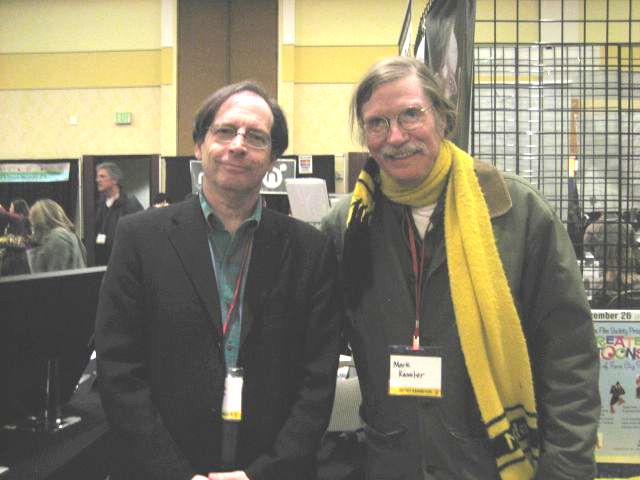 Presenting Col. Shuffle and Aces Wild at the CTN Expo, the weekend of Nov. 19-21, Burbank, Ca., after a three day poker game (That’s Jerry Beck on the left, and yours truly on the right). I was just about ready to go home when this was taken; I actually sold four cels from “It’s ‘The Cat'” to friends and strangers at the mighty Expo. Jerry had copies of his books on “Madagascar 2” and “The 100 Greatest Looney Tunes” for sale, which he autographed. In addition to the cels, I sold some scrap film and some Little Orphan Annie collections, one of which was bought by Moebius (Jean Giraud), famous French cartoonist. He watched “It’s ‘The Cat'” on my little monitor and enjoyed it quite a bit. I did not anticipate that this year’s Expo would be an even bigger hit than last year’s. The crowds were really lined up for all the panels and programs. I couldn’t go to any of them, because I was just trying to do business. Speaking of business, you can still buy cels from “It’s ‘The Cat'” anytime, free shipping and DVD included, just go to www.itsthecat.com, and go into the Gallery section. Click on Film Art, and you will be in production cel heaven. While you are there, consider giving something original for the Holidays! Help out my producer Greg Ford, and maybe get “There Must Be Some Other Cat” out a few days sooner. A special thanks to Milton Knight, for contributing to the Greg Ford Fire Fund. You’re now an Ailurophile!
Presenting Col. Shuffle and Aces Wild at the CTN Expo, the weekend of Nov. 19-21, Burbank, Ca., after a three day poker game (That’s Jerry Beck on the left, and yours truly on the right). I was just about ready to go home when this was taken; I actually sold four cels from “It’s ‘The Cat'” to friends and strangers at the mighty Expo. Jerry had copies of his books on “Madagascar 2” and “The 100 Greatest Looney Tunes” for sale, which he autographed. In addition to the cels, I sold some scrap film and some Little Orphan Annie collections, one of which was bought by Moebius (Jean Giraud), famous French cartoonist. He watched “It’s ‘The Cat'” on my little monitor and enjoyed it quite a bit. I did not anticipate that this year’s Expo would be an even bigger hit than last year’s. The crowds were really lined up for all the panels and programs. I couldn’t go to any of them, because I was just trying to do business. Speaking of business, you can still buy cels from “It’s ‘The Cat'” anytime, free shipping and DVD included, just go to www.itsthecat.com, and go into the Gallery section. Click on Film Art, and you will be in production cel heaven. While you are there, consider giving something original for the Holidays! Help out my producer Greg Ford, and maybe get “There Must Be Some Other Cat” out a few days sooner. A special thanks to Milton Knight, for contributing to the Greg Ford Fire Fund. You’re now an Ailurophile!
Otto Messmer’s expertise in drawing all kinds of cartoon cats is in evidence in the dailies this time (3-9 to 3-14-1936) but Fooy Tu Yu tricks Felix away from the pound and out of the diamond and throws him into a safe! In the 3-15 Sunday page, Felix is still stuck in the sixth century where even the food is in armor.
Krazy is from 8-26 to 8-31-1940 this time. More puns and mixed associations this week, due to Krazy’s “Kat Langwitch” and twisty reasoning. I love the cow in the 8-30, and Herriman’s staging in the last panel of the 8-31; Ignatz standing on a platform just below the lip of the plateau, as Pupp laments the uselessness of his jail.
Patrick is from approximately 5-31 to 6-4-1966 this time. We learn that Elsa’s last name is “Primstone”, and that she collects movie magazines. Of course, Patrick has no scruples about smashing a bug with one of them. For the next several batches of strips, there will be educated guesses about the exact dates of a few of them, since I didn’t write the info down when I clipped them from the St. Louis Post-Dispatch, and Dad was a little more relaxed about buying every issue of the paper in the summer time. I’m not even sure if these comics are from 1966 or not, they may be a couple of years earlier than that. I met two of my readers at the Expo who really seem to like Patrick, and were a little bit amazed that I clipped them so carefully in my childhood. Comic strips really had me dazzled in those days, they were free (for me), and I really looked forward to each day’s installments of the stories, especially L’il Abner, which also ran in the Post-Dispatch. I’m very happy to have readers who come back to read the strips each post. It’s a little harder to post as frequently over the holidays, but I’ll try!
Taken With A Grain of Salten
Hello everyone! Thanks Charles, Milton and Fortunato for helping to identify the Halloween mystery strip (Muggs McGinnis), and for the nice comments on Vic Vac’s cartoon from the Globe-Democrat. I’m glad you enjoyed it. Felix this time is from 3-2 to 3-8-1936. The adventures of Fooy Tu Yu and Punk Chow continue, as Felix escapes from them with the diamond to the CPS (Cat Protector Society). They shelter Felix, but Fooy pays a tramp to “adopt” Felix from the CPS. Take a look at the last panel in the 3-7, I love the variety of cats in that panel, and the very beat-up black tom cat that the tramp is holding. In the Sunday, Noah tosses Felix off the ark, and the scientist brings Felix forward through Time (400 BC to 490 AD).
Krazy comes to us from 8-19 to 8-24-1940. Bricks hidden everywhere this week, some falling from the sky by parachute. In the 8-23, Offissa Pupp and Ignatz are pining for the school to re-open. In the 8-24, the Elephant’s Feet formation from the Coconino County Navajo Tribal Park is evident in the background. If you haven’t been to Monument Valley, you must go if you’re a Krazy Kat fan. When Cathy and I went there some years ago, my favorite formation in the Park was “The Thumb”. Just a hunk of rock that looked like an 8 foot high thumb. We may run across it in a future KK strip.
Patrick is from 5-23 to 5-28-1966 this time. Godfrey (5-23 to 5-25) is a lot like Charlie Brown. Patrick and Elsa make like Lucy and Patty and beat up on him emotionally. Patrick even uses his fists for “good reasons” in an exact parallel of Lucy and Linus’s dialog. Just let anybody try to make a “Charlie Brown” out of Patrick!  In the 5-26 to 5-28 strips, Hancock reverts to his more familiar gags. They never spare the corporal punishment in Patrick land. Sorry about the tape stain on the 5-28, don’t repair your newsprint clippings with adhesive tape, folks.
I’m still on my Felix Salten kick, I borrowed “Perri” from the library, and read it. Now I’m reading a very obscure Salten entitled “15 Rabbits”. “Perri” turned out to be a very gentle story, compared with Bambi and Jibby the Cat. Perri grows up from babyhood, escapes being killed and “marries” Porro. The main focus of the book, is on the little girl who is under four years old. She can understand animal language and is visited by birds and deer, with whom she converses. Perri and Porro also talk with her. The book concludes as Perri and Porro return to the little girl after many adventures. However, she has aged a year or so, and can no longer understand animal talk. Perri and Porro are very downcast at losing their friend. Kind of a bittersweet ending, especially when you compare it with the Disney “Perri” story, with it’s cute “together time” songs, etc. Bambi and some of the stags from the “Bambi” book make cameo appearances in Perri’s forest and are hunted down by HIM again. There is some killing and blood, but it’s not quite as stark as in Jibby and Bambi. I found an alternate translation of JIBBY THE CAT in the Glendale public library called DJIBI, and it’s even bloodier that the version I have. The farmer gets tired of Jibby, and in the last chapter, throws a flat iron (?) at her, killing her. The killing is offhand, not sentimental at all. It made me wonder what the author’s true feelings about Jibby were. DJIBI is the British version of the book, published in 1946. Speaking of BAMBI, go to http://www.archive.org/details/DeerStoryChap.10 and you’ll hear 19 minutes of yours truly carrying on the oral tradition. I read Chap. 10 of BAMBI, in which Bambi’s mother is killed by HIM. Some of the dialog and situations are close to the Disney film, but the reader can’t help being saddened by Mom’s total inability to protect herself from HIM, and by extension her child. The “don’t fly” line, spoken by the pheasants in the film is here. One of the rabbits dies in a very human way, trying to deny that it’s leg is mortally injured until the very end. The line the old Stag speaks, “Your Mother can’t be with you anymore”, isn’t in the book. Salten has Bambi asking everyone if they have seen his mother, but only concludes that he never saw her again. He spares us the bloody details of Mom’s demise. Please listen in, I don’t make too many mistakes. I lack editing software, so I have to do these in one take!
BOOO!!
Hi Everyone! Happy Halloween! Do you remember when big city dailies had LOCAL cartoonists to decorate their pages? In St. Louis in the 1930s through the 1970s we had “Vic Vac” (Victor Vaccarezza), the “Chief Artist” of the St. Louis Globe-Democrat. That’s a picture of him up there in the Globe-Democrat art dept. in 1931. He’s in the middle of the photo, near the trash can. He was very adept at funny “crowd” cartoons, and usually did the holiday front covers for the “Sunday” magazine section of the paper. His aerial perspective reminds me of Dudley Fisher’s “Right Around Home with Myrtle” Sunday pages. He had a great Halloween imagination, I like the little green ghost shoving the moon aside so that the haunted house can be moved. In St. Louis, it was a relatively common occurrence for an older home to be moved from one lot to another, sometimes rolling there on large logs placed under the first floor. This cover is from October 28, 1962.
Also from 1962 is this “mystery” daily drawn by Wally Bishop. I saved a few of these because I like dachshunds (sorry, cats). Our first family dog was a dachsie named Schatzie. One day she ran away from us and never returned! My brother and I loved her, and this strip reminds me of her. The dachshund is called “Junior”, here. Anybody know what the strip’s actual title was?
Felix this time is from 2-24 to 3-1-1936. Felix continues to foil Fooy Tu Yu’s gang, and sits on the chimney to their hide out twice, once to warm himself, and once to “smoke” them out. I love Messmer’s dialog in the 2-29, “Again, I laugh at the villains.” That could be the title of a Felix strip collection. In the Sunday (3-1), Felix says Messmer’s favorite word, “Fine”, and Noah says “So!” in the last panel. Where would Otto be without “So and Fine”?
Krazy this time is from 8-12 to 8-17-1940. The strip’s mostly “for the birds”, featuring three days of bird themed gags. In the 8-15, Krazy takes the term “Watch your step”, literally. Krazy’s strict interpretation of stock phrases also is the basis for the 8-17, in which Krazy reads a barometer.
In Patrick, from 5-16 to 5-21-1966, Patrick is true to form, hitting little Suzy, his most ardent admirer, and getting close to Charlie Brown territory as the baseball game is rained out. Godfrey isn’t called upon to do the “rain, rain, go away” gag, that Linus did so well. Speaking of Peanuts, maybe some of you watched “It’s The Great Pumpkin, Charlie Brown” on ABC last week. I enjoyed seeing old friend Bill Littlejohn’s appealing animation of Snoopy and Lucy. I liked the staging of Snoopy’s emergence from the pumpkin patch as one cel just slides north with an eerie sound effect. If this was an ideal world, ABC would have dedicated the hour to Bill Littlejohn, who passed away just a few weeks ago. The Peanuts specials wouldn’t have been as lively without Bill’s funny drawings. Not so very long ago, we used to look forward to animated specials on television. Now they are very rare critters indeed. And I, for one, don’t look forward to them anymore. Now go out and raid your neighbor’s storehouses, that’s what Halloween is for.
More Comics
Hi readers! There seems to be at least some interest in the Felix comics I’m posting, so here’s some more: 2-17 to 2-23-1936. Felix continues to elude the menacing men of China by running away with the diamond. The men fight among themselves and Felix throws onions at them causing a tear gas effect. The way is clear for Felix to escape through the roof. Another Messmer characteristic is to substitute “home remedies”, such as onions, for more lethal things like tear gas bombs. Sort of like making an airplane out of a dachshund and some oxygen balloons. In the Sunday, Felix mucks about with the Professor’s time machine to the Noah’s Ark era, and is rejected from the ark! This page must have looked beautiful in color with all the Messmer animals, but I don’t have it that way.
In the Krazys this time (8-5 to 8-10-1940) Mimi goes on a vacation leaving the principal cast devastated (they are all in love with her). In the 8-10, they learn she has a boyfriend, and revert to type. You will notice in strips such as the 8-8, Herriman put a lot of care into the rugs in Ignatz’s house that change in every panel. A lot of papers ran the strip severely cropped at the bottom, to save space. Because of this parsimony on the part of newspapers, cartoonists had to cram the dialog and the main figure action in the top two-thirds of the strip. Chester Gould’s Dick Tracy was designed that way in the early 1940s and so the Kat was truncated as well. These strips are the full size, top to bottom, so we get to enjoy all of Garge’s beautiful designs.
Patrick in the strips from 5-9 to 5-14-1966 enjoys mistreating Elsa and yelling at a bubblegum machine, while Godfrey eats several of Elsa’s mud pies to avoid hurting her feelings. I’ll bet Patrick grows up to be a spousal abuser.
Thanks for all the great comments on my last post! I will have another BAMBI reading posted soon.
Falling Leaves by the Salten Sea
Hi everyone. We’ve been on a Felix Salten kick lately. I bought a copy of Salten’s JIBBY THE CAT for my wife Cathy’s birthday, and we both read it. It was not the children’s book it seemed to be, but a rather sober and grim look at a cat’s life from both the wild and domestic side. Salten doesn’t spare the blood or the death, and we both laughed and cried reading the book. I had never read Salten’s BAMBI. JIBBY whetted my appetite for more Salten to the point that I checked out BAMBI from our public library. I love the Disney cartoon feature version of the story very much, but Salten’s novel is a very different deer from the Disney version. It’s not so much “love is a song”, but “Can’t you stay by yourself?” Disney’s subtext is the “circle of life”, but Salten’s is that all creatures, including man, are mortal and there is a higher power over us all. I have continued the oral tradition this time by reading one of my favorite deleted scenes from Disney’s BAMBI, the “Leaf Scene”, and also reading Salten’s original version of the scene from Chap. 8 of BAMBI. The Disney script used many of Salten’s lines from the book, but rearranged them and assigned a definite sexual identity to the leaves. In Salten’s book, once a leaf is severed from the limb, it loses all power of speech and life, but in Disney’s script, the leaves seem to have life even as they fall and wind up next to each other on the ground, giving a hopeful quality to the scene. The sketches above are from Robert D. Field’s book “The Art of Walt Disney”, as is the text of the “Leaf Scene”. Early treatments for BAMBI, anthropomorphized not only leaves, but even the raindrops, the original version of the “Little April Shower” song was called “I Like Falling” by Frank Churchill. In it, the raindrops are actually singing about how they enjoy falling from the sky. The screenplay of BAMBI evolved to the point that only the animals were anthropomorphic, and a lot of the proposed cast was dropped, such as a chipmunk and a squirrel character. Disney made major characters out of Thumper the Rabbit, “Friend Hare” in Salten’s version, and the owl, a Screech Owl in Salten’s version. The major change is that the Disney script is a matriarchy, with Bambi’s mother being very central, versus Salten’s patriarchy, with the Old Stag, Bambi’s father, becoming his son’s chief adviser and role model (“Can’t you stay by yourself?”) Here is a link to my audio on Chapter 8: http://www.archive.org/details/LeavesChap.8 . In future posts, I’ll read a bit more from Salten’s BAMBI, it is a remarkable and very affecting book, and really NOT for children.
Felix is from 2-10 to 2-16-1936. Felix and Danny Dooit run from the cobra and it turns on Punk Chow and Fooy Tu Yu. Felix becomes a high wire artist to retrieve the diamond from a clothesline. I like Messmer’s control of graphics to suggest Fooy Tu Yu’s change of mood in the 2/13, in panel one, he has rounded hands and rounded fingers as he talks to Danny, in panel two, Fooy’s hands and fingers change to menacing points as he chases Danny and Felix. In the Sunday, Felix is a hero again, as he retrieve’s the Professor’s radio from a thief. In the next to the last panel, a favorite Messmer word shows up in Felix’s speech: “Fine! It Worked” Messmer used “Fine” over and over again in dialog both in the strip and the comic books. Maybe Otto was a fan of the “Vic and Sade” radio show of the 1930s, one of the characters from that show, Uncle Fletcher (Clarence Hartzell) always said “Fine!”, when he wanted to cover up for his ignorance of a topic.
Krazy is from 7-29 to 8-3-1940. Ignatz is in trouble with his wife for bringing Mimi so many apples, and when Mimi sets up a private school of her own, the principal cast play hooky.
Patrick is from 5-2 to 5-7-1966. Godfrey, Elsa and Suzy wind up on the fuzzy end of an ice cream cone and a baseball bat, and Patrick is on the wrong end of a hypodermic needle.
I completed the scene of animation I mentioned last week. The characters were Private Snafu and the Technical Fairy, for Steve Stanchfield’s upcoming DVD with upgraded copies of all the Private Snafu cartoons, including a few that didn’t make it into “The Complete Private Snafu” videotapes of years ago. I really found myself enjoying drawing the characters, they were designed by Art Heineman to be fun to animate, and they are! Steve liked my animation and the drawings have been shipped to him. I was afraid I couldn’t animate or operate the test computer after such a long time, but it all came back to me. Maybe I’ll get to do another scene someday, maybe not. Experience counts not for a thing in today’s “animation” marketplace. Great working with you, Steve!
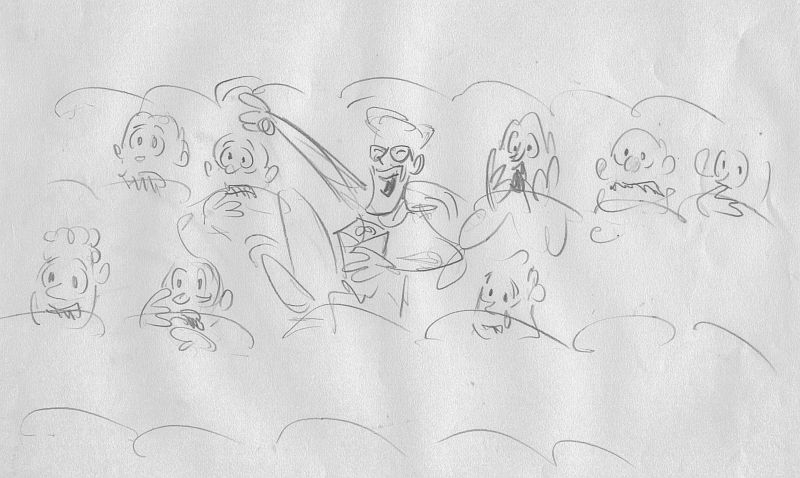





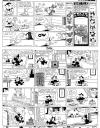






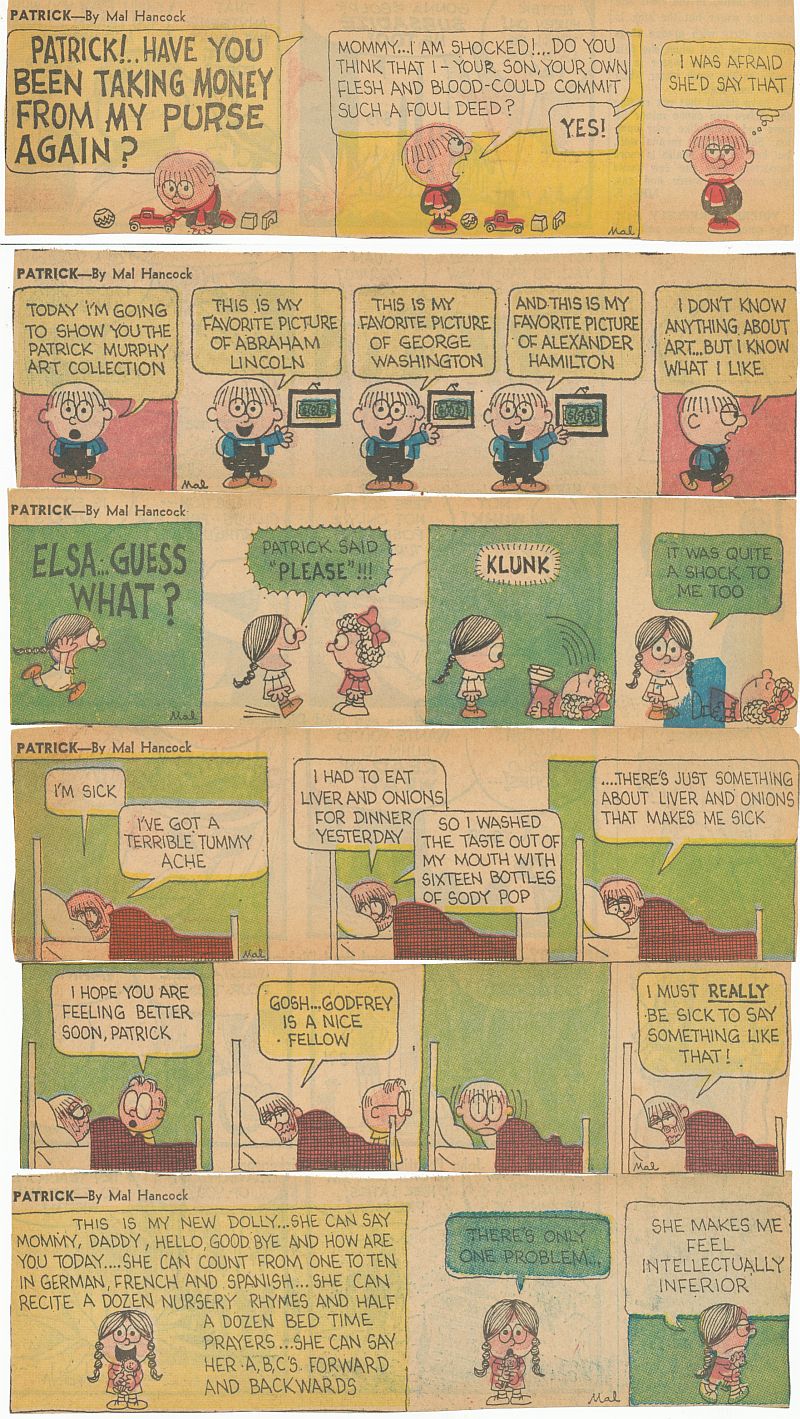
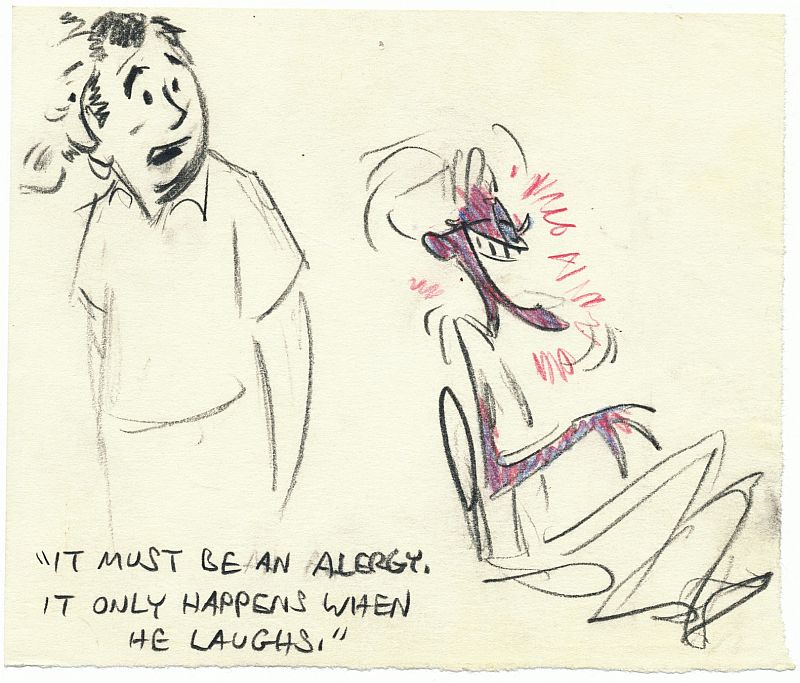















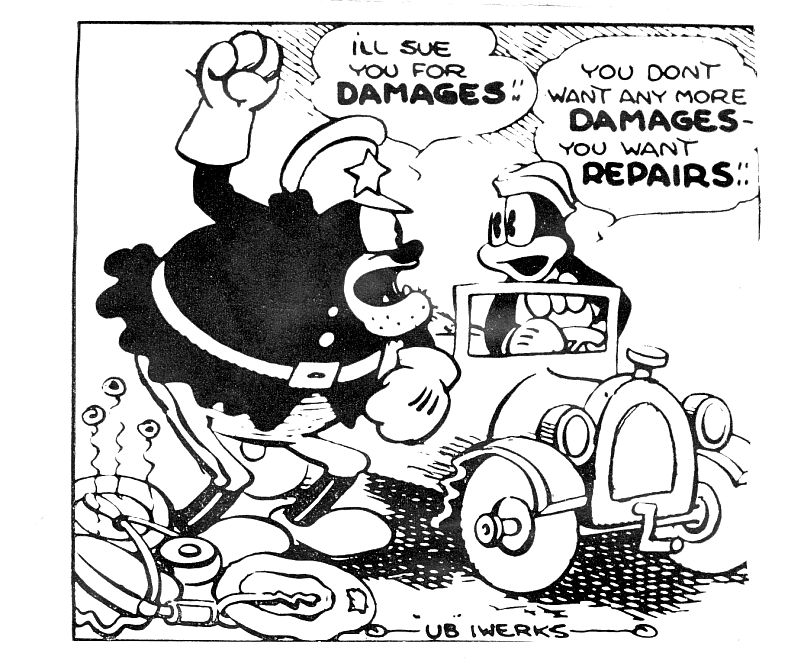
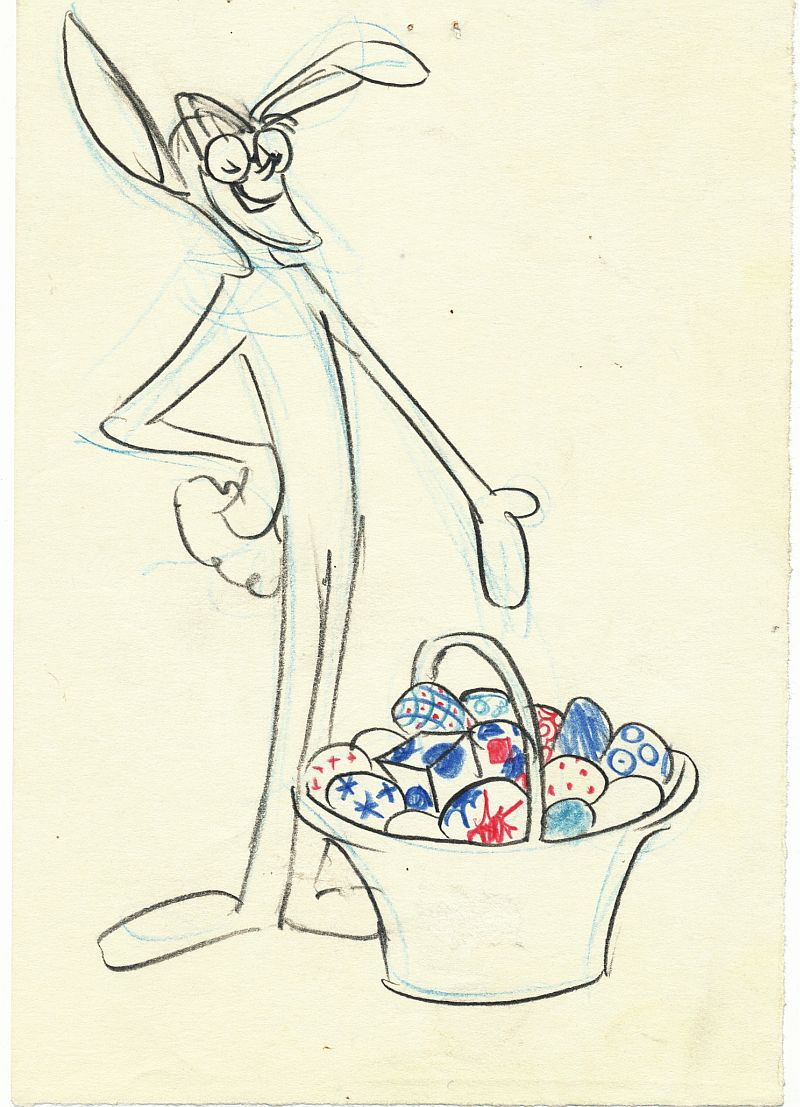














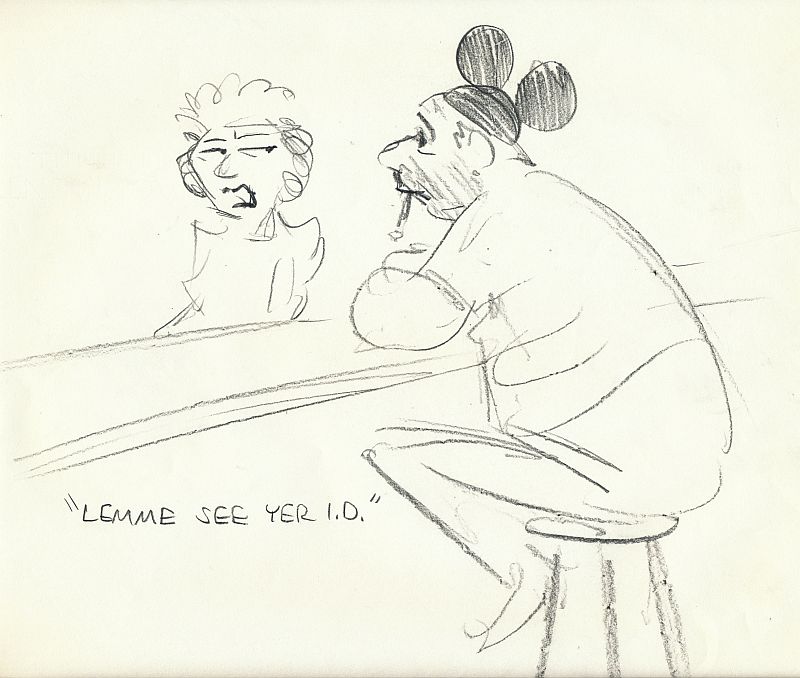














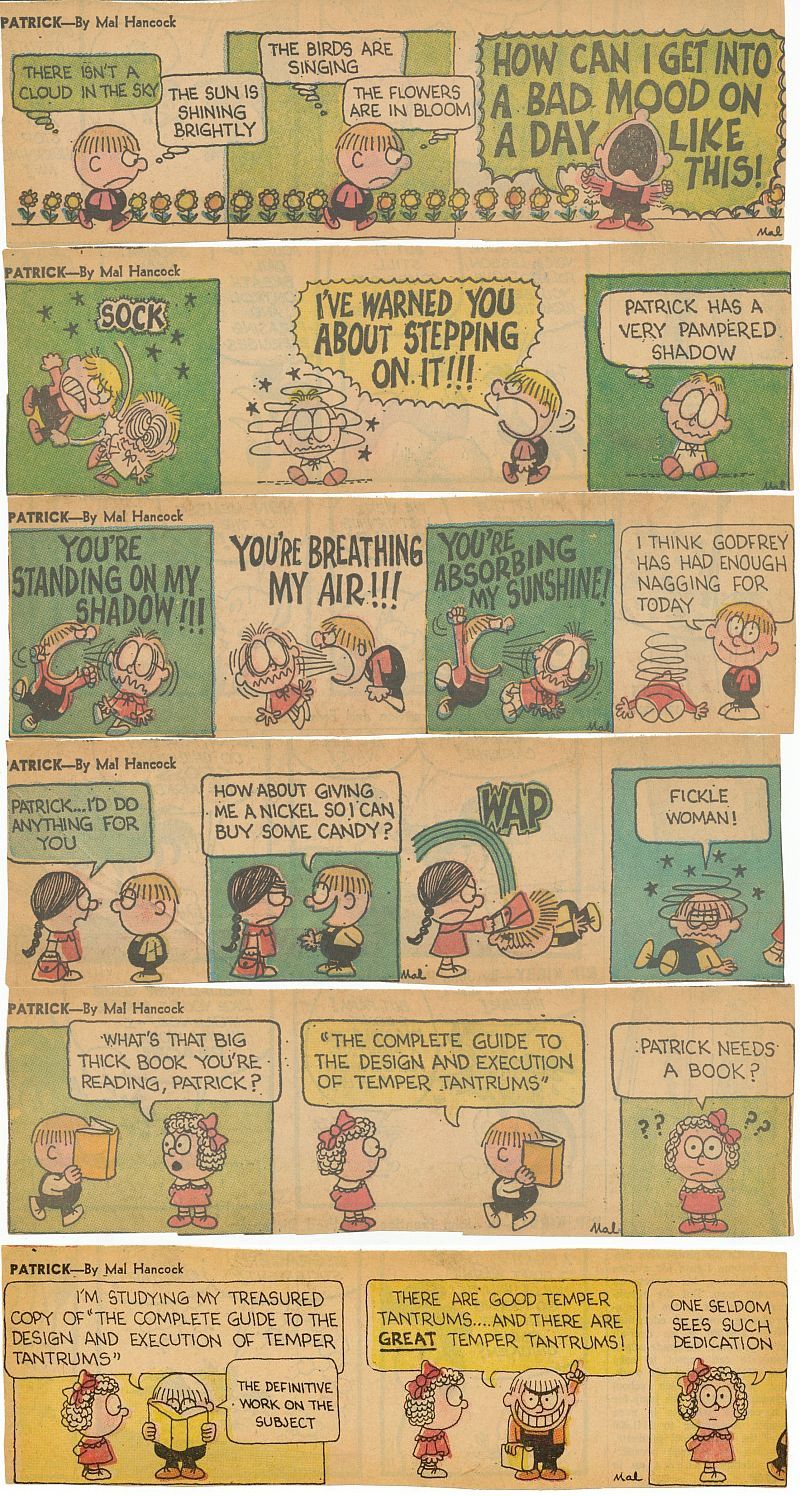
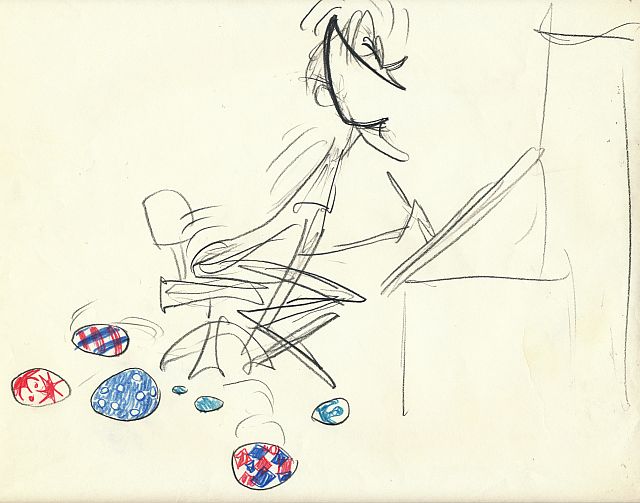













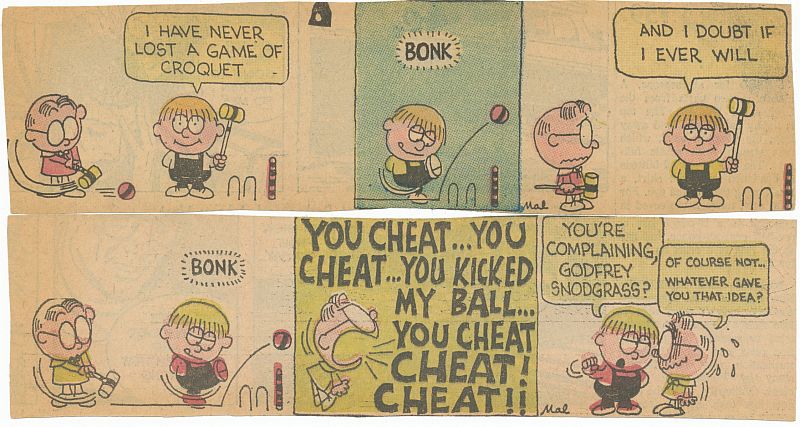
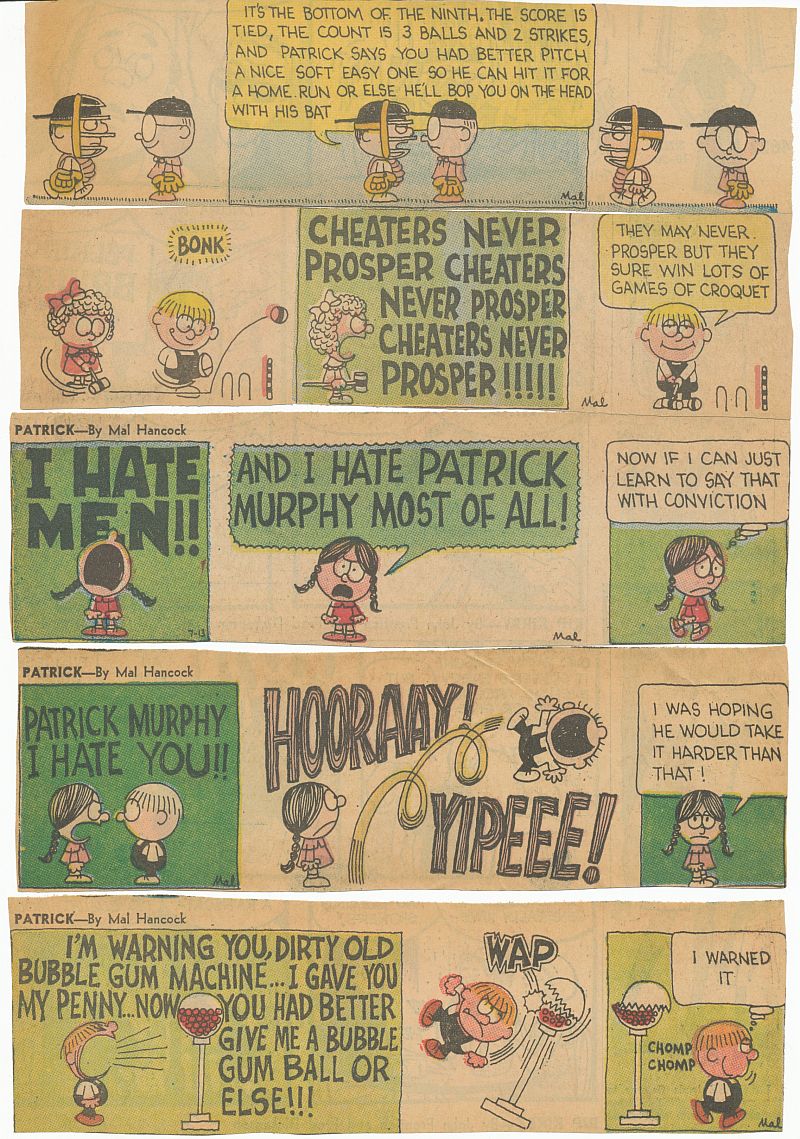

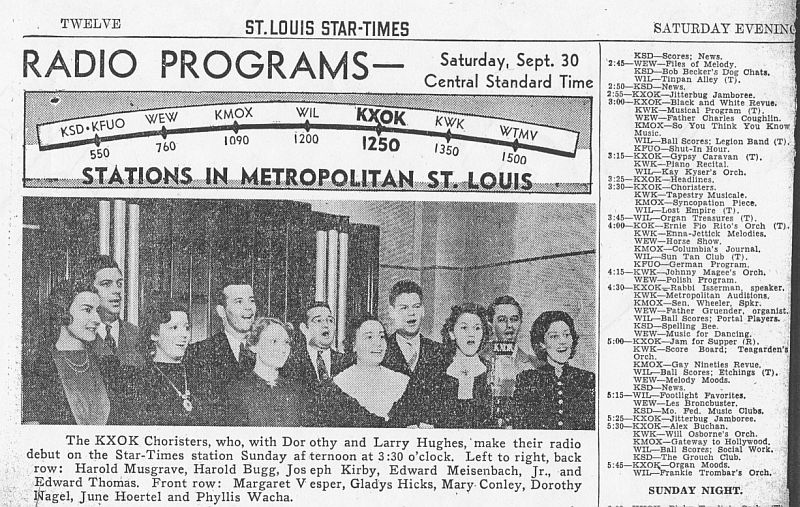















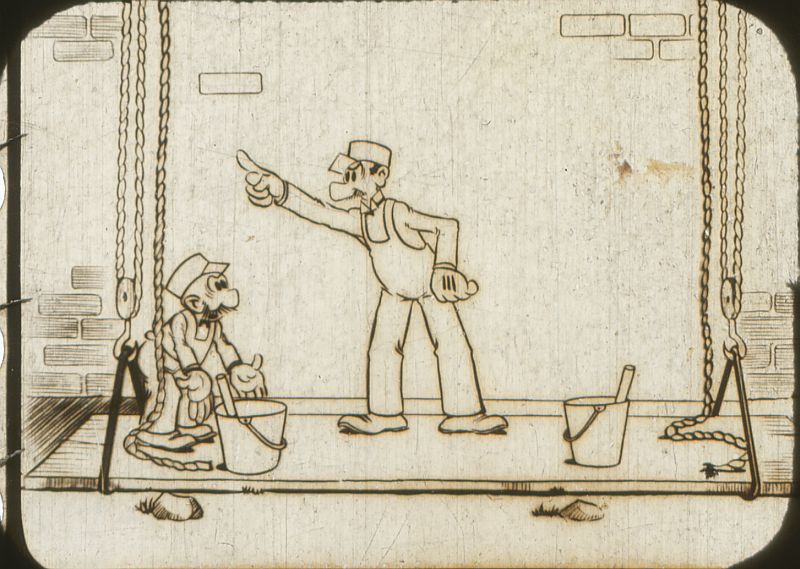













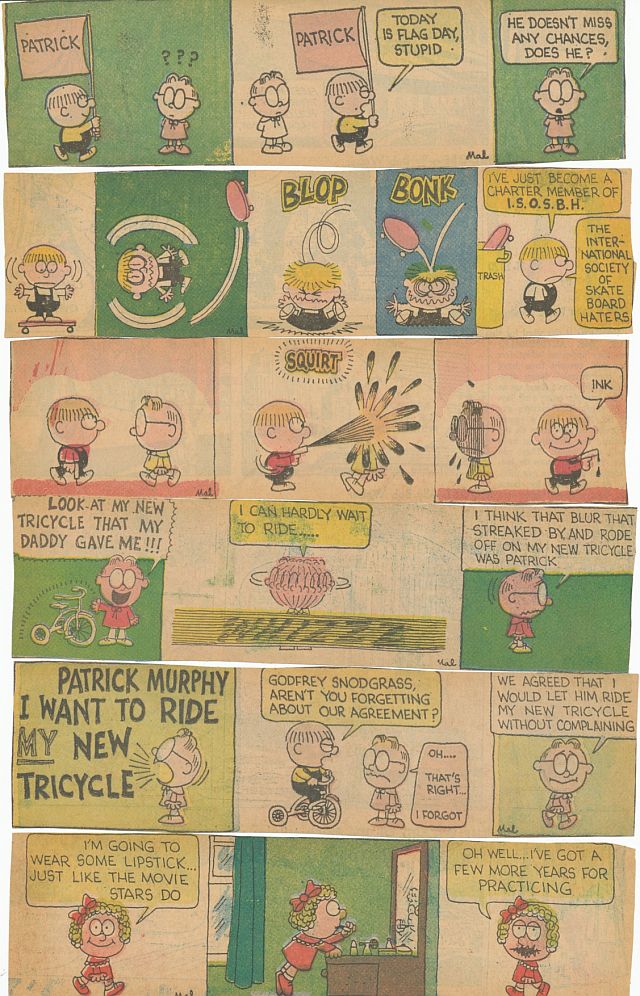
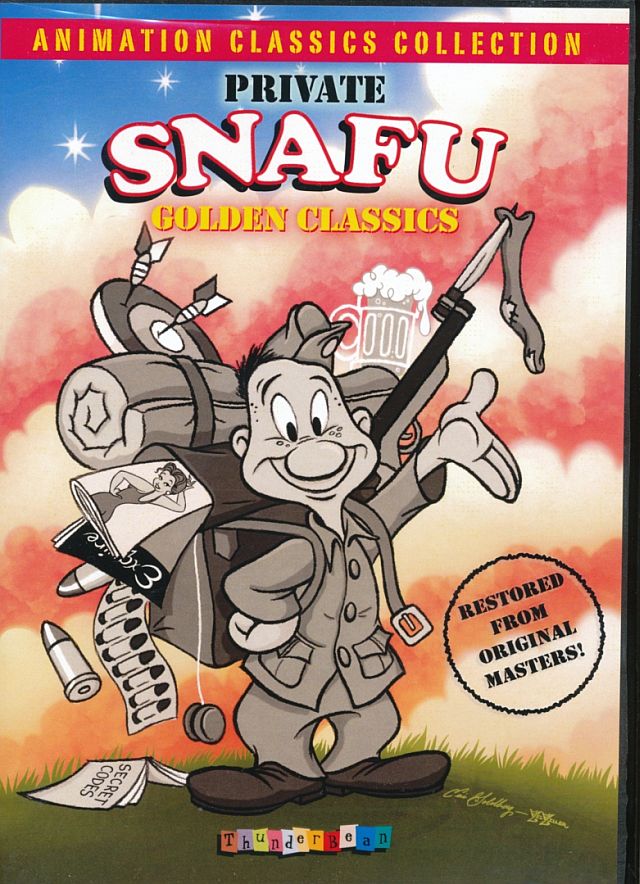




























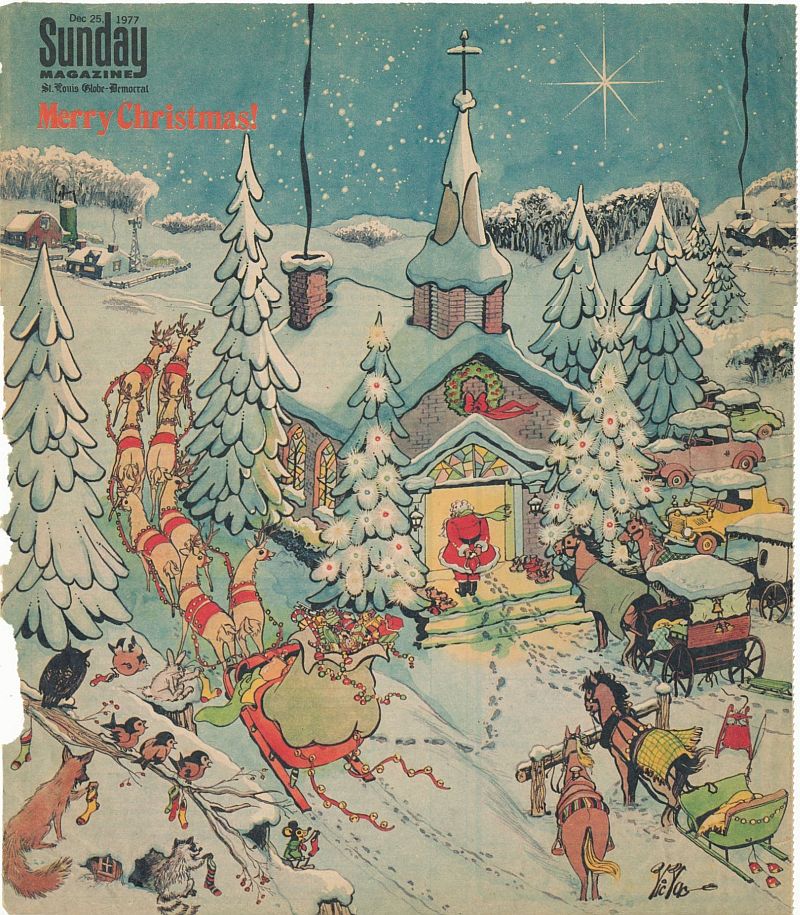
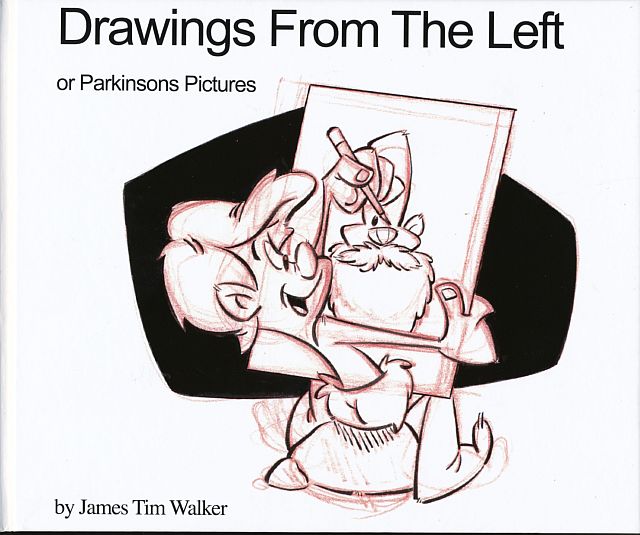
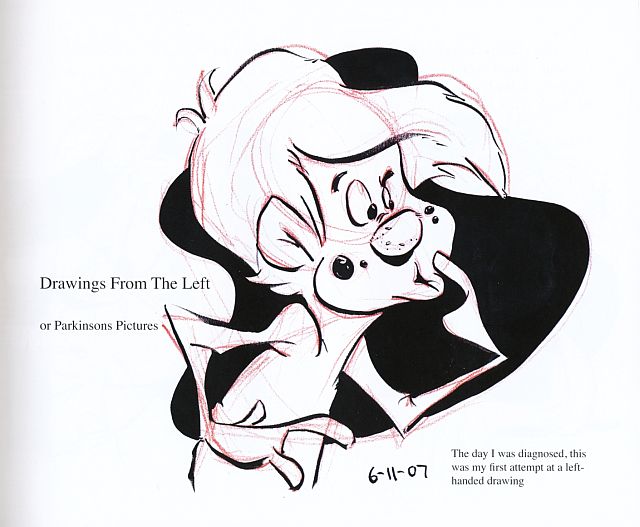














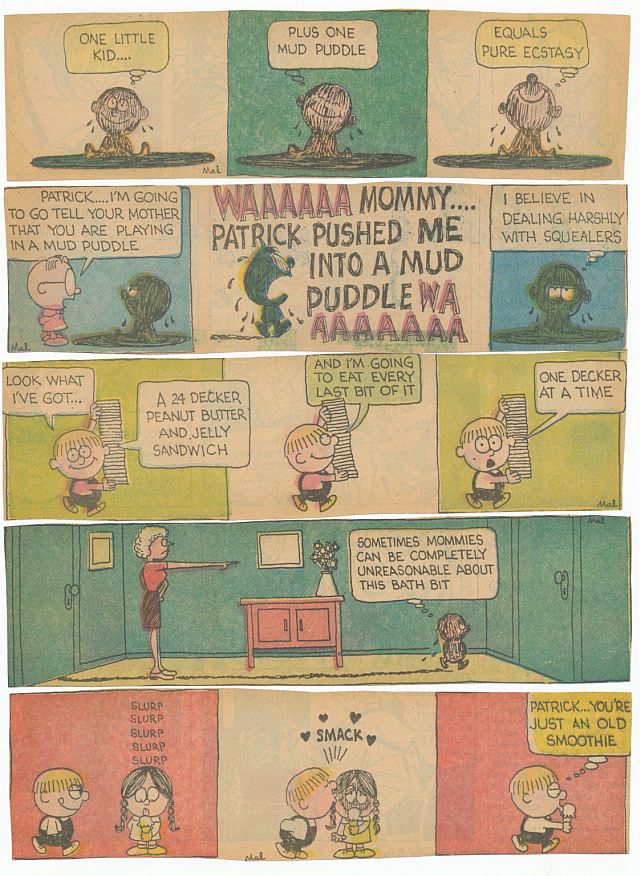













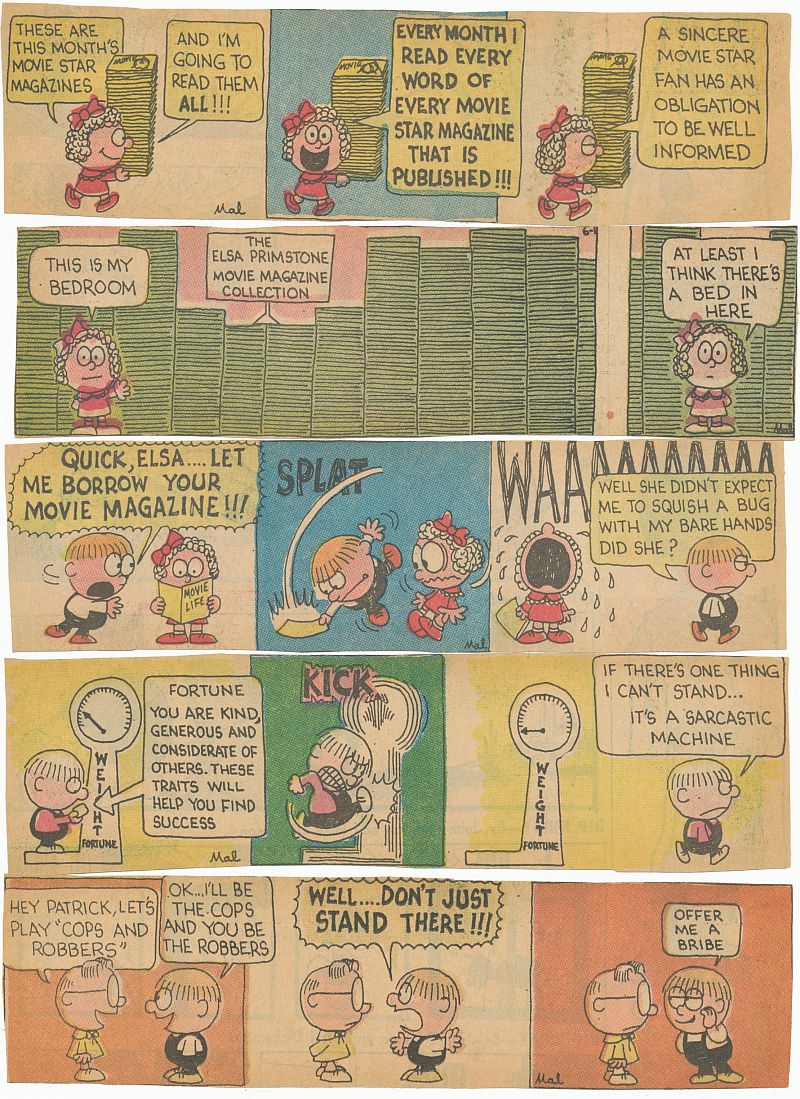













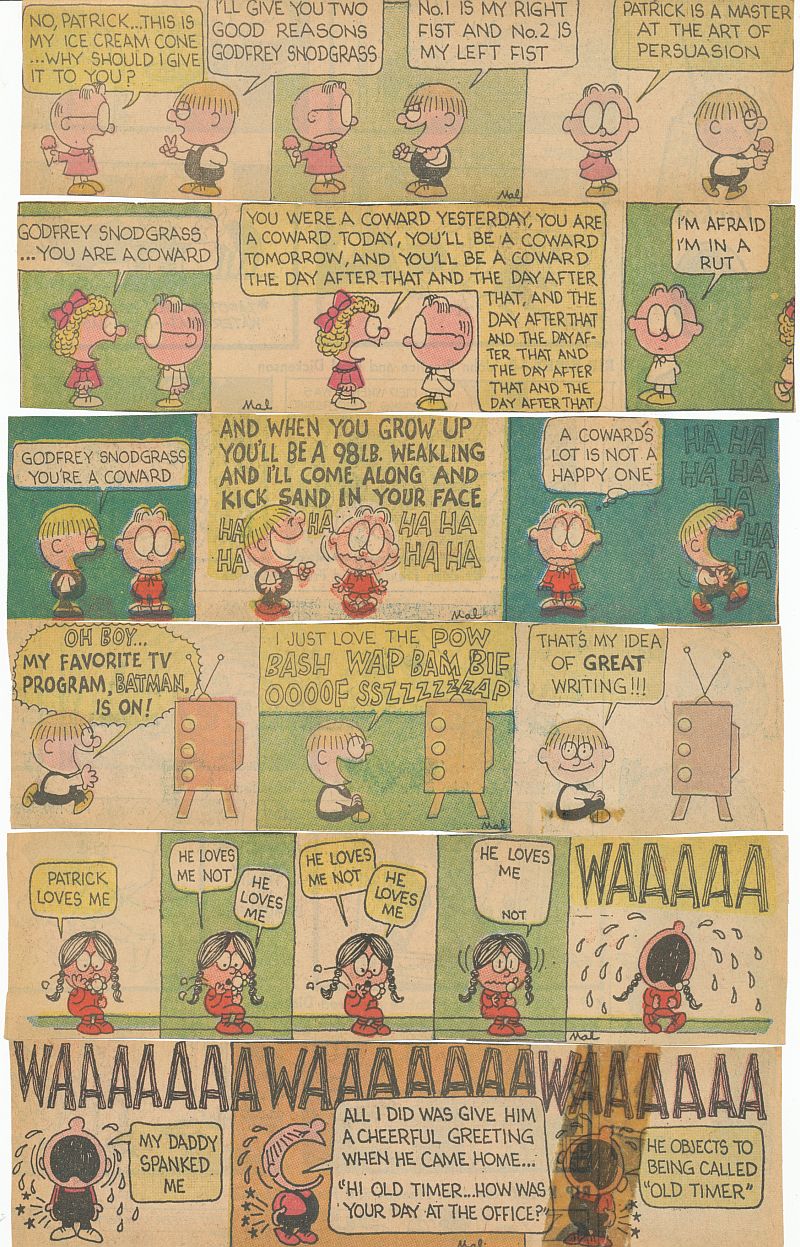
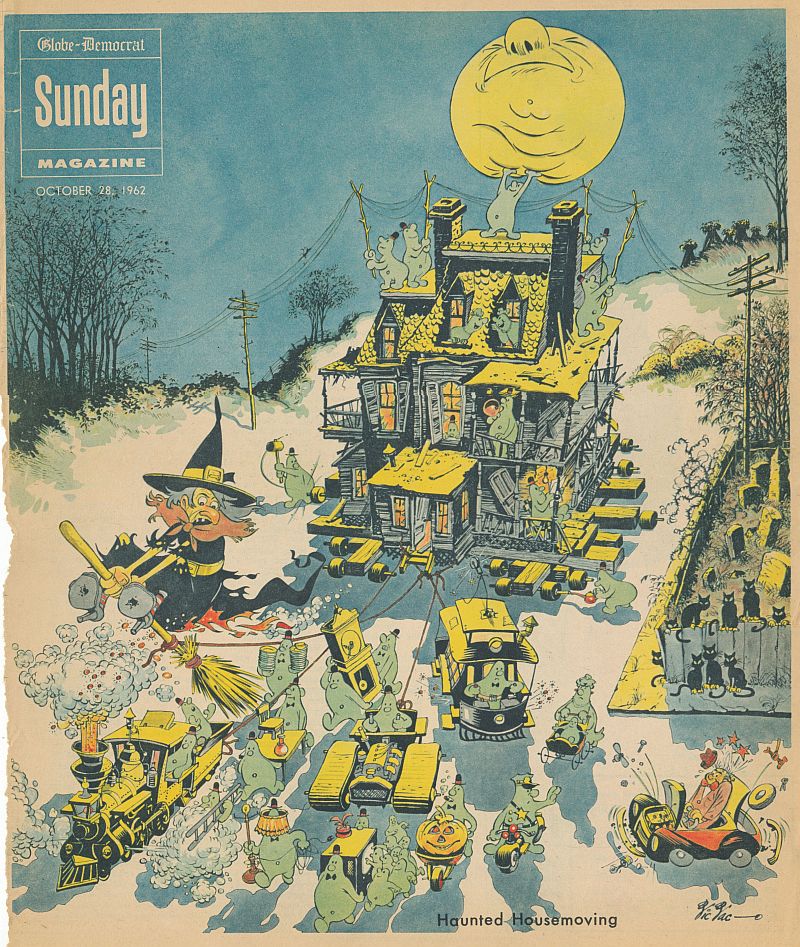
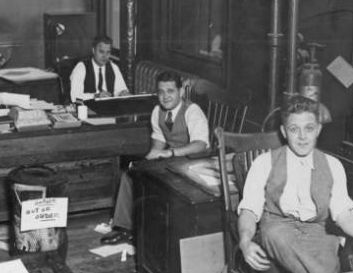




























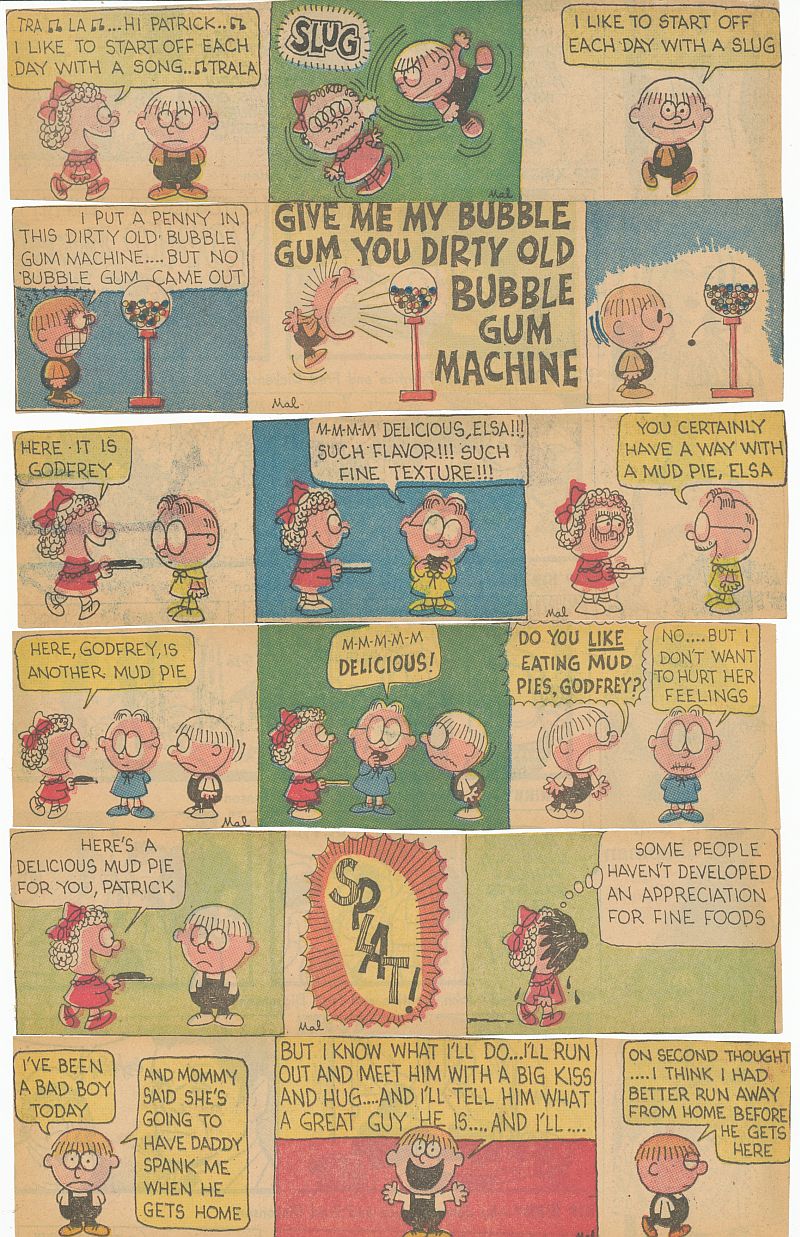
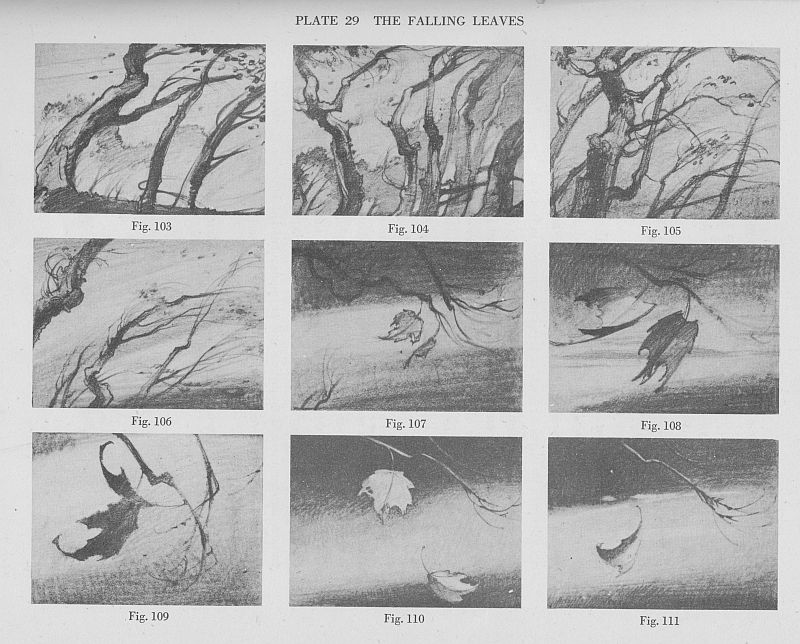













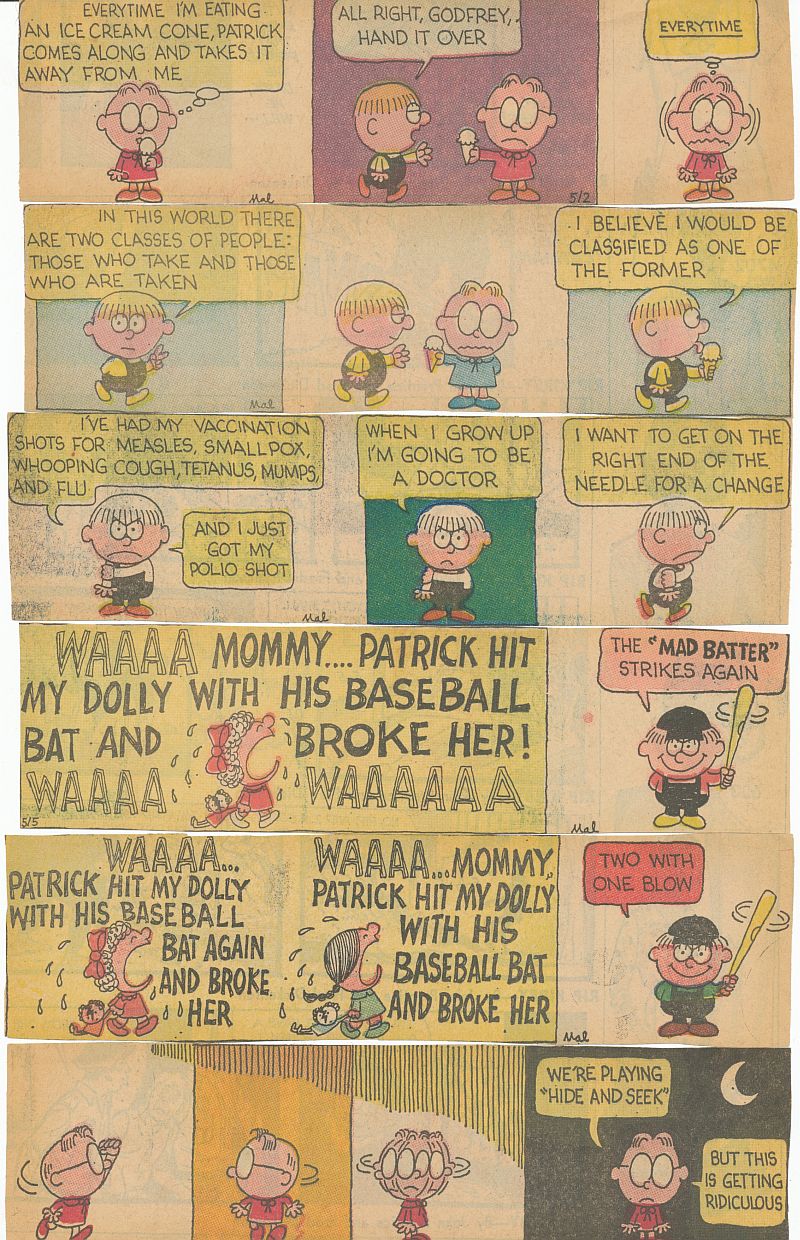
John Sparey on Allen Wade, Dick Hoffman and Money!
May 17, 2011
Uncategorized
5 Comments
Mark
Hi Folks, the John Sparey letters continue! But first, there’s news of “It’s ‘The Cat'”! The Annecy Animated Film Festival in France has requested a print of “It’s ‘The Cat'” for a survey of American Independent Animation which will be screened three times during the Festival! We made the cut! I have no idea how many animated films the Festival considered for this program, but I’m surprised and happy that our cartoon will be included. Greg Ford, my Producer, is quite enthused as well. It will be screened during the Annecy Festival June 6th to 11th, if any of my readers can attend.
   That’s a John Sparey drawing at the masthead of the post this time. For some reason, John caricatured me as a duck and Tim as a mouse, John took great amusement at Disney fans, since he had worked for the Mouse and “graduated” (as he put it). I’ve forgotten exactly what prompted this drawing, it was a long time ago (1969). Here is a letter that John wrote from the Motion Picture Country House and Hospital in 2006, where he was living after his collapse. He writes this time about a mistake I made in identifying a caricature he made during his time at Disney. I thought a drawing he made of Gary Mooney looked like Allen Wade. By the number of times John mentions Allen Wade, and keeps underlining his name, I think it’s obvious there was some kind of ill-will there. Allen Wade was quite a character, Tim Walker and I both knew him and visited his place a few times. Allen was a key assistant animator at Disney, probably in the early 1950s, the same time John was there. I think he worked on Sleeping Beauty. By the time I met him, Allen was pretty dominated by intoxicants, but he was a funny guy, and fun to be around. He loved movie history, Errol Flynn, Basil Rathbone, W.C. Fields (Allen could do a funny impression of Fields). Most of all, Allen was a fan of Bing Crosby, the early, pre-singer’s nodes Bing. I can see how a nervous type, which John tended to be, would be irritated by Allen, but to Tim and me, he was a friend and loved to share his collections and Bing Crosby records with us. Gary Mooney was an assistant at Disney, he worked on Lady and the Tramp, and a very good free-lance animator on commercials. I met him when he worked at Quartet Films, and he broke me in on some inbetweens on a Green Giant commercial. Gary worked for Bob Kurtz in later years. John Sparey writes about Dick Hoffman, who was another Disney assistant who came up the ranks with John.  Later, Dick became an animator at Filmation and stayed with them until the studio closed. It’s kind of sad to read about how Dick Hoffman wound up at the Motion Picture Country House and John’s attempts to remind Dick of the old days at Disney. John also reveals the various weekly wages he was paid over the years. $31.92 at Disney in 1953! I wonder how John managed on that. Leaving Disney was a pretty smart move on his part financially. (John spells Allen Wade’s first name as “Alan” in his letter, I’ve left it as he wrote it.)
Mark,
You may wonder why you are receiving all of this unsolicited material. Just lucky, I guess. You were the first person to advise me that the Anim. Guild was posting my Disney gallery of art on its website. That was on your Christmas card. And you mentioned my caricature of Alan Wade…alan wade??!! I had drawn Alan Wade? I had no recollection of it whatsoever. This prompted my deeper involvement in the computer lab here. The “Alan Wade” portrait was about the last of my drawings posted by the Guild. That was not Alan Wade! That was NOT Alan Wade!! That was NOT ALAN WADE!!! It was Gary Mooney. Gary is also in my mini-mural, “Disney Bull Pen, 1954”, seated at the desk. And Dick Hoffman was also in the group.
Gary is also in my mini-mural, “Disney Bull Pen, 1954”, seated at the desk. And Dick Hoffman was also in the group.  And both Dick and Gary were in my seven dwarf line-up.
And both Dick and Gary were in my seven dwarf line-up. I never worked with either of them after we “graduated” from Disney, but I kept some awareness of Gary’s moves in the business. However, I heard very little about Dick. At one point, I learned that he had been in a bad car accident. Some years later, I spotted him at a large Union meeting where Ed Asner delivered a prepared speech encouraging us to go on strike. His speech completed, he (Dick) pivoted quickly toward the Exit and was gone. Then he turned up at an art exhibit organized by Phyllis Craig at Film Roman. I hadn’t identified him; he seemed so shrunken, and he needed a voice box so that I didn’t even have his normal voice to identify. Having done my mental double-take on hearing his name, we tried some trivial chit-chat. We had never been “pals”. But he had managed to stay out of the hospital habitats all this time until now. So when I was told a few months ago that a “Richard Hoffman” I might have know from animation had recently joined us, I knew it couldn’t be good news. Following a physical collapse somewhat similar to mine, he has been spending most–if not all—of his time in bed. After going to ask about chances of planning a visit with him (in a different wing), I was led directly to his room. I was not prepared for a monologue conversation. His battery operated voice box was not working. The visit was not a success. I slunk away. Realizing that I had materials to use as an excuse for a second visit, I downloaded prints of my two pictures that include him. It went well. He’s alert and clear-minded. He knows that visitors can sometimes have trouble understanding him and is prepared to write notes. He recalls various events we shared, so I came up with a group of studio gags as an excuse for a third visit. But I still need props.
I never worked with either of them after we “graduated” from Disney, but I kept some awareness of Gary’s moves in the business. However, I heard very little about Dick. At one point, I learned that he had been in a bad car accident. Some years later, I spotted him at a large Union meeting where Ed Asner delivered a prepared speech encouraging us to go on strike. His speech completed, he (Dick) pivoted quickly toward the Exit and was gone. Then he turned up at an art exhibit organized by Phyllis Craig at Film Roman. I hadn’t identified him; he seemed so shrunken, and he needed a voice box so that I didn’t even have his normal voice to identify. Having done my mental double-take on hearing his name, we tried some trivial chit-chat. We had never been “pals”. But he had managed to stay out of the hospital habitats all this time until now. So when I was told a few months ago that a “Richard Hoffman” I might have know from animation had recently joined us, I knew it couldn’t be good news. Following a physical collapse somewhat similar to mine, he has been spending most–if not all—of his time in bed. After going to ask about chances of planning a visit with him (in a different wing), I was led directly to his room. I was not prepared for a monologue conversation. His battery operated voice box was not working. The visit was not a success. I slunk away. Realizing that I had materials to use as an excuse for a second visit, I downloaded prints of my two pictures that include him. It went well. He’s alert and clear-minded. He knows that visitors can sometimes have trouble understanding him and is prepared to write notes. He recalls various events we shared, so I came up with a group of studio gags as an excuse for a third visit. But I still need props.
One of the records that I have kept from the time I started at Disney is a list of my weekly salaries. So I can accurately report that for my first week at Disney in April of 1953, I earned $37.84 as a beginning apprentice inbetweener, with a take-home pay of $31.92. By April of 1954, I had moved up to temporary breakdown and a salary of $69.94. That was almost exactly what I was getting on Crusader Rabbit in Hollywood in 1951, once you translate my $300.00 monthly pay into weekly terms. I neglected to keep payroll records for my 6 weeks with Jay Ward on C.R. in Berkeley in 1950. I spent 1952 in the Navy as my reward for staying in the inactive reserve. By the time I “graduated” from Disney in March, 1958 I was an Asst. Animator earning $104.08 plus “Sleeping Beauty” overtime. Moving over to TV Spots as a beginning animator on the new C.R. in color automatically bumped me up to $145.00 a week. Two years of automatic raises had lifted me to $200.00 a week. I was ROLLING in dough!
But Enough of That.
Felix is from 1-7 to 1-13-1935 this time. Danny Dooit enters the action in the 1-7, this time as a Boy Scout. Felix gets knots tied in his tail, so Danny can practice his Scout knots, and in the 1-11, Felix once again is pitched head long out of the house. Danny uses the opportunity to dress the Cat’s wounds. I love the drawing of Felix hitting the tree, beautiful cartooning. On the twelfth, Messmer builds suspense by a knock on the Dooit’s front door. I love the howling dog in the Sunday page, he reminds me a lot of the early Pluto. He might be an early version of Flub, the pup, which Otto used in the Felix comics of the 1950s and 60s.
Krazy this time is from 11-11 to 11-16-1940. The action centers mostly on Ignatz’s ‘Brick-Rocket’. Ig ties a brick onto a sky rocket and aims it at Krazy, Offissa Pupp unwittingly completes the firing in the 11-14. The ‘Brick-Rocket’ becomes a boomerang in the 11-16. I like the subtle rhyming gag in the 1-11 as well. By this time, we are so familiar with the “Ignatz+Brick=Jail” equation that we can complete it for ourselves.
Patrick is from approximately 9-9 to 9-15 this time, with “9-15” on top. There is almost a month’s gap between the strips from the last post to this one. Probably summer vacation took place and nobody was around to save the papers. I love Patrick’s “complex” about Godfrey’s color TV, pretty new technology in 1966, and his relentless count-down to Christmas shopping which pushes his “Mommy” over the edge. Sorry that I can’t date these more accurately. Back in my strip-clippin’ days I was lucky to have time to clip them, let alone date them and put them in the correct order. I’m much more meticulous about my newspaper clippings now, but I do a whole lot less of them. I love newspapers, but don’t even subscribe to one, I just accept my neighbor’s copy when she’s through with it.